

22 Best Football Stadiums in Europe You Should Visit
Modern football has been around for more than 150 years and still remains one of the most popular sports worldwide. Europe and football have a very close connection. The game is engraved in the soul of every European and is sometimes rightfully referred to as “The unofficial religion of Europe.” Football stadiums have a strong connection with the people.
In fact, you can’t actually be wrong in believing and saying so, because football is more than just a game here. Every street and city has football fanatics with zealous and spirited hearts waiting to see their favourite stars in action.
Due to such massive support and following, it is not a surprise that there are many stadiums and fields in almost every city of Europe. Some boast structural wonders in the array of stadiums, while some are famed for hosting unforgettable football moments, and then some give you the best of both. The strong memories held like wax and wane, glee and sorrow still smell fresh in our memories.
Let us dive into some of the most famous, heart touching, beautiful structures we call football stadiums in the land of palaces and castles – Europe.
Table of Contents
1. Camp Nou, Spain
2. wembley stadium, london, 3. croke park, dublin, 4. signal iduna park, dortmund, 5. santiago bernabéu stadium, 6. stade de france, paris, 7. luzhniki stadium, moscow, 8. san siro, milan, 9. atatürk olympic stadium, istanbul, 10. old trafford, manchester, 11. allianz arena, munich, 12. athens olympic stadium, 13. millennium stadium, cardiff, 14. stadio olimpico, rome, 15. olympiastadion, berlin, 16. wanda metropolitano, madrid, 17. stade vélodrom, marseille, 18. murrayfield stadium, edinburgh, 19. estadio da luz, lisbon, 20. national arena, bucharest, 21. stadion feijenoord, rotterdam, 22. parken stadium, copenhagen, uefa 2020 with talk home – football stadiums.
Stadium Capacity: 99,354

Camp Nou, the home ground of the Catalan champions FC Barcelona, is more than a stadium. Since its inception in the 1950s, it’s been a proud symbol of Catalonian culture and football supremacy. It is among the biggest football stadiums globally and the largest in Europe with a capacity of 99,354 seats with plans to reach 100,000 seats with state-of-the-art modifications, reflecting the team’s reputation.
The gigantic stadium brings back the time of the Roman Empire and the impression of the majestic gladiatorial arenas. Since 1957, the arena has hosted home games of FC Barcelona, and since 1992, the stadium serves as the base for the Catalonian national team. It has hosted two Champions League finals and the 1998/99 season Champions League final, the one where Manchester United splendidly defeated Bayern.
Spain hosted the 1982 FIFA World Cup, and undoubtedly, Camp Nou was the venue for one of the semi-finals. In the same year, 121,000 people joined the mass congregation here in the presence of the Pope for a Mass.
Stadium Capacity: 90,000
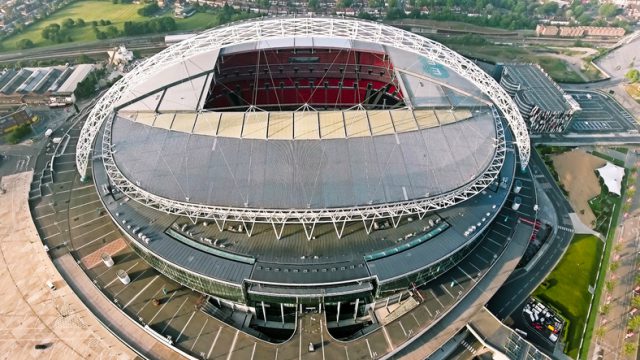
Wembley Stadium is the ultimate destination every English club wants to reach and is one of the most famous football stadiums in the world. The second-largest stadium in Europe, following the Camp Nou, is the conventional playing arena of the English national team. And an ultimate perfection of English football stadiums.
The stadium was rebuilt on the designs of HOK Sport and Fosters & Partners, opened to the public in 2007 with a total capacity of 90,000 people. The smart building has a retractable rooftop and the well-known Wembley Arch. While some might say the new structure doesn’t have the charm, it certainly has an electric atmosphere.
Wembley is the home of the English National team and hosts all the major domestic club competitions. The FA Cup final, the League Cup final and the FAA Community Shield are held at Wembley. In addition, two UEFA Champions League finals have been hosted here, in 2011 and 2013. Now the Euro 2020 cup final is also scheduled to be held here.
Similarly, the NFL International Series and many music concerts have also been held at the massive venue. Wembley has an enticing history, modern look, and facilities that make it the best stadium in the world.
Interesting Read: Get the Best of Europe – Your Ultimate Travel Guide
Stadium Capacity: 82,300
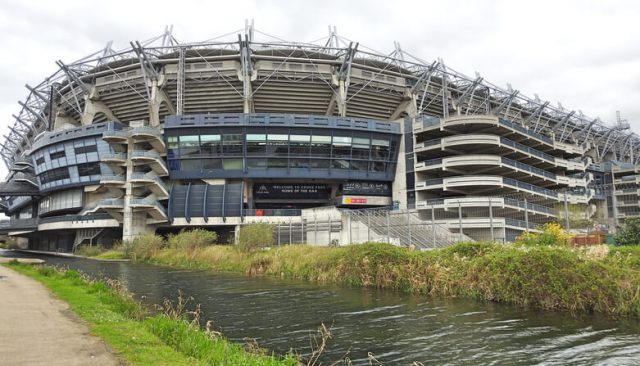
The iconic Croke Park stadium is named after the infamous Archbishop Thomas Croke of Ireland. This stadium serves as a national stadium for Ireland and the Gaelic Athletic Association (GAA) headquarters. Since 1891, GAA has hosted Gaelic sports, including the annual All0Ireland in Gaelic football and hurling sports event.
Other momentous events held at the stadium include the closing and opening ceremony of the 2003 special Olympics. Numerous musical concerts have also been held at this stadium. The primary developmental work of the stadium was held between 1991 and 2005. Over these years, the capacity of Croke Park Stadium has been raised to over 82,300 spectators.
The stadium also symbolises what can be achieved if a cohesive volunteer force works together for a unified goal. The matchday at Croke Park represents the commitment, challenging work, and dedication of over 2,200 clubs from all the 32 counties of Ireland. The atmosphere and colours engulfing the stadium during live matches display the skills and athleticism of the players on the pitch.
This stadium is utilised for events, from field sports to concerts and bespoke banqueting. The Croke park stadium actively offers guests and match patrons unrivalled facilities to enhance their experience.
Stadium Capacity: 81,365
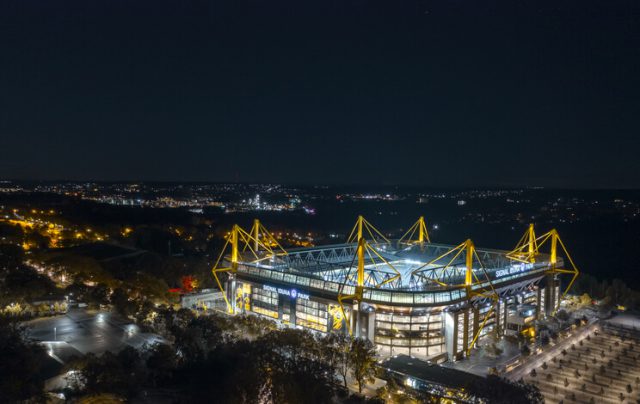
The largest stadium in Germany, Signal Iduna Park, hosts over eighty-one thousand fans and provides the best entertainment to football fans across Germany. This is one of the largest and most comfortable stadiums across Europe. Over millions of dollars are spent by Borussia Dortmund in Dortmund to renovate the stadium and keep the pitch clean.
The scene found on Strobelalle – known as “The Temple” by fans and routinely named “The excellent stadium within the country” by the press, experts, and VIPS alike is the biggest stadium. The stadium was redesigned for the run-up of FIFA 2016. However, certain works are carried out on the stadium each year, with BVB contributing millions of Euros to redesign the field.
For the reconstruction work, both the south stand was reinforced through measures, and concrete sanitation measures were executed within the northern portion of the stadium. Seven new modern boxes were made while an impressive digital technology providing enhanced security was introduced. Moreover, new scoreboards were also installed to give the stadium an all-out latest look.
Stadium Capacity: 81,044
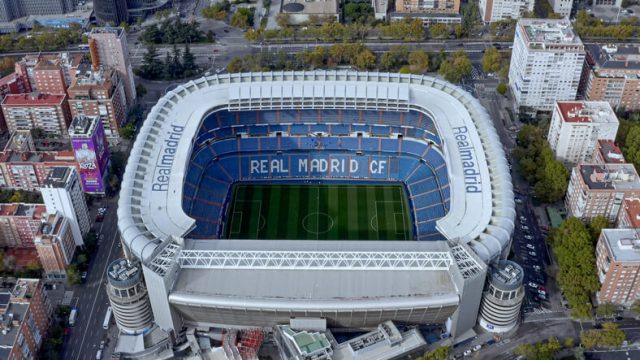
The second-largest stadium in Spain, Santiago Bernabéu, is home to football fans in Spain. The stadium was completed in 1947, and since then, the stadium has hosted multiple football matches and provided endless entertainment to football lovers across Europe.
Santiago Bernabéu is named after the former footballer and Real Madrid President Santiago Bernabéu, the greatest footballer of his time. Over these years, the stadium has hosted the UEFA Champions League on four occasions. Moreover, the final match of the European Nations Cup in 1964 and FIFA World Cup 1abck in 1982 were also held at the same stadium.
Currently, a renovation project is in progress, which will increase the stadium’s capacity by 4000. Furthermore, the stadium’s height will also increase, and a new retractable roof will be added. Roman techniques will be utilised so that the stadium’s operation is not affected. By lifting the roof like the Romans, they will bring innovation to the stadium.
With this innovation, they intend to introduce more restaurants, a shopping centre, and a hotel with a view of the pitch. Moreover, the renovation teams aim to make it a digital stadium equipped with a 360-degree view of the whole stadium.
Stadium Capacity: 81,000
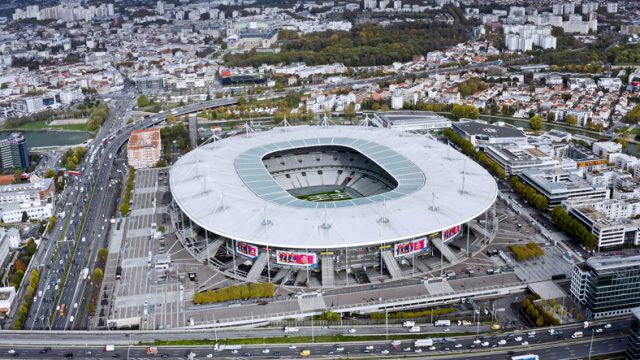
The home ground of the French National team since 1998, Stade de France is the stadium where France defeated Brazil in the 1998 FIFA World Cup Final. The pride of the french people, it has hosted many Champions League finals and Euro 2016. It is the seventh-largest stadium with a capacity of 81,000 people.
Similarly, the largest stadium in Europe for track and field events, housing 78,338 people in that configuration. The venue will host the opening and closing ceremonies of the 2024 Summer Olympics and matches of the 2023 Rugby World Cup.
UEFA has listed the stadium as Category 4 and hosted the UEFA Champions League finals in 2000 and 2006, also the 1999 and 1007 Rugby World Cup. That makes Stade de France one of the only two stadiums globally that have hosted both a football world cup final and the rugby union world cup final.
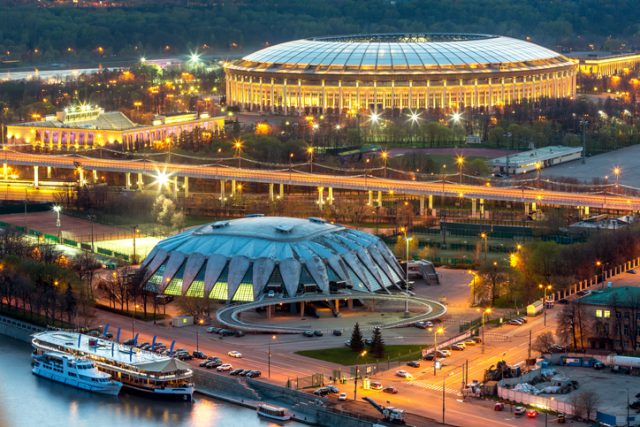
The Luzhniki Stadium, formerly known as the Lenin Stadium, is the national stadium of Russia. Built between 1955 and 1956, this stadium was a dire result of the ambitions of the Soviet leadership to upgrade the sports facilities of the country. Over these years, the stadium has served as a centrepiece for the Olympics and has also hosted the opening and closing ceremony of the game.
In 1999, Luzhunki Stadium hosted the UEFA Cup final held between Parma and Marseille. Moreover, the final of the Champions League between Manchester United and Chelsea was also held in the same stadium.
With Luzhunki Stadium having a history of hosting certain iconic matches in the history of football, there are no clubs associated with the stadium. This stadium is used as a home stadium for the Russian national football team. From time to time, the stadium has also been used for various other supports and concerts. It has also been used to host the finals of the Russian domestic cup.
This stadium has exclusive observations areas to help people with disabilities enjoy their favourite sports of the season. Moreover, after renovation, the stadium was also equipped with special extra-wide seats for plus-citizens. In short, this stadium has been crafted to meet all your needs.
Stadium Capacity: 80,000
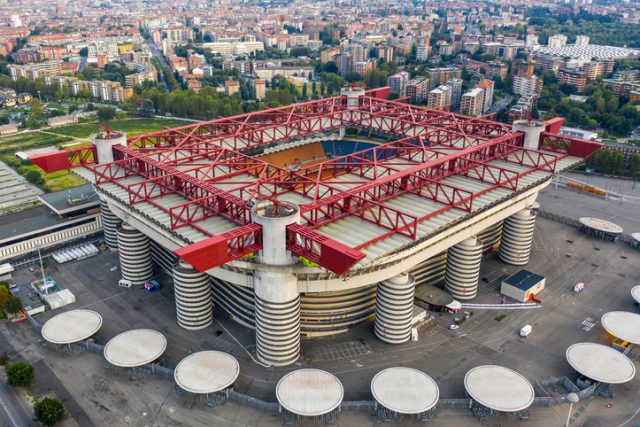
San Siro or the Stadio Giuseppe Meazza, is shared by two teams’ fans: AC Milan and Inter Milan. And it is among the most famous stadiums in Europe with its unique structure. The stadium was built in 1926 and opened with an inauguration match between Inter and AC Milan. It was packed with 35,000 spectators where Inter defeated AC Milan 6-3. And twice every year, the long rivalry is played out in the Derby Della Madonnina.
San Siro is the pride of Italy and a must-visit destination for football fans around the world. The stadium has a massive capacity of 81,000 people even though it was developed in 1926. The stadium was mainly designed for football and didn’t have the general athletics track around the perimeter found in most Italian stadiums.
San Siro has hosted four European Cup finals, including the 1934 FIFA World Cup, 1990 FIFA World Cup, the UEFA Euro Cup 1980, and the 2021 UEFA Nations League finals.
Stadium Capacity: 76,092
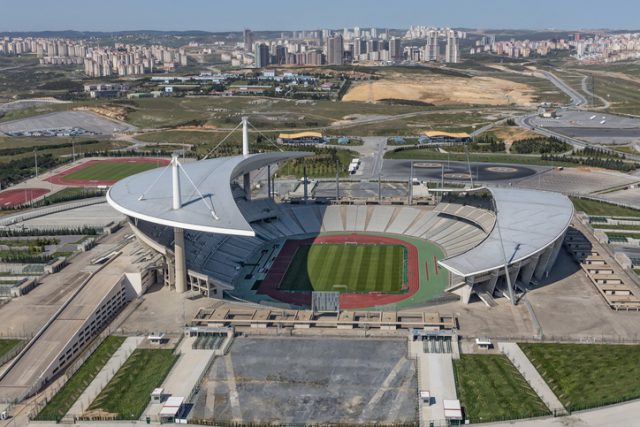
Located in the heart of Turkey, Atatürk Olympic is the largest stadium in the country. This stadium is named after the first President of the Republic of Turkey – Mustafa Kemal Ataturk. The stadium’s construction started in the year 1999, and it was completed in 2002. The foremost reason behind the construction of this stadium was the 2008 Olympic games that were awarded to Beijing, China.
The stadium gained the title of ‘5-Star Sports Complex’ by UEFA events. The iconic finals of the UEFA champions league between Milan and Liverpool were played at Ataturk Olympic stadium in 2005. The stadium was also set to stage the second finals of the Champions League, but the match was postponed due to restrictions due to the Covid-19 pandemic.
The stadium has been used by the Super League football team as their home stadium. Moreover, Sivasspor and Besiktas played their few home games at the Ataturk Olympic stadium. During the 2003-2004 season, Galatasary played their home matches at the stadium due to construction works performed at their own Ali Sami Yen stadium. This symbolises that the stadium has been used often by other teams across Turkey.
The Ataturk Olympic Stadium is in the centre of Istanbul within a semi-urban area alongside the motorway. There aren’t many restaurants around this area. Therefore, it is suggested that you do your eating and drinking within the city of Istanbul.
Stadium Capacity: 76,000
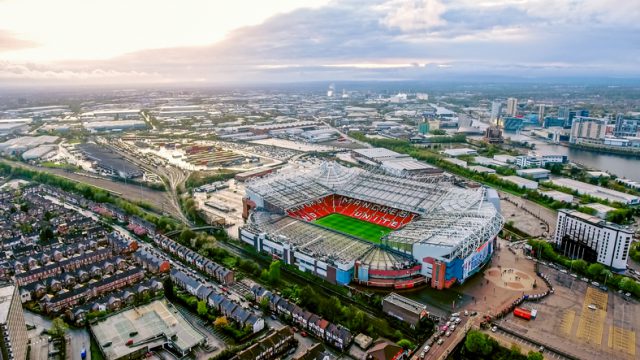
The Home of Manchester United, nicknamed the “Theatre of Dreams” by Sir Bobby Charlton, was built in 1909. The all enclosed stadium could seat 44,000 people back then, which was increased in 2007 to 76,000 seats. That made it the second biggest stadium in England after the Wembley stadium and the biggest club stadium in Great Britain.
The iconic ground has hosted legendary players like Sir Body Charlton, George Best, Eric Cantona, David Beckham, and Cristiano Ronaldo, who made history with their games.
For many people worldwide, visiting Old Trafford would be a dream come true. It symbolises the beginning of sporting events in the continent, landmarked with the first European game played against none other than the legendary Real Madrid in April 1957.
Old Trafford is among the most iconic football stadiums around the globe. After developing the modern structure of the post-Taylor era, the stadium joined top European avenues. It hosted the 2003 Champions League final, 2012 Olympic Football, 2021 Rugby League World Cup, and UEFA Women’s Euro 2021. The Red Devils supporters have many epic tales of the battles fought at their home ground through the years.
Stadium Capacity: 75,000
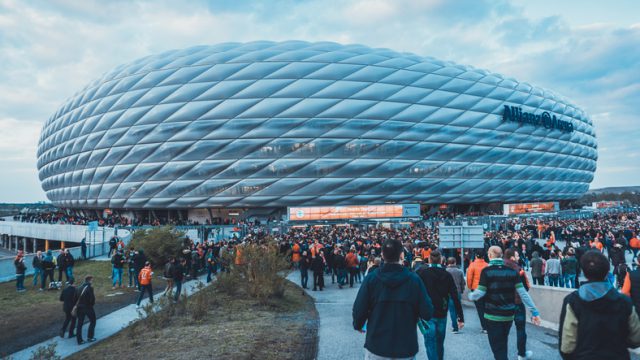
Allianz Arena is an architectural wonder and the most iconic stadium of the 21st century, featuring a beacon shape. The beautiful stadium, nicknamed Schlauchboot, “dinghy”, is covered in inflatable plastic bubbles. The bubble-shaped panels adorn the sides and make it a striking sight when the colour changes, which can be ideal for hosting different football teams and colouring according to each team.
The first stadium in the world with full colour changing the exterior is a marvel in itself. The German champion’s hometown stadium was opened in 2005 with a seating capacity of 70,000 for international matches and 75,000 for domestic games.
Primarily Bayern Munich uses the arena, but 1860 Munich also plays here. The name of the stadium changes every time FIFA and UEFA events happen here due to the policies forbidding corporate sponsorship. The stadium was referred to as FIFA World Cup Stadium, Munich during the 2006 FIFA World Cup and Football Arena Munich during the UEFA club and Nations League match.
The stadium hosted the 2012 UEFA Champions League final and will host the upcoming 2023 final. During the UEFA Euro 2020, the stadium will host three groups and one quarter-final match.
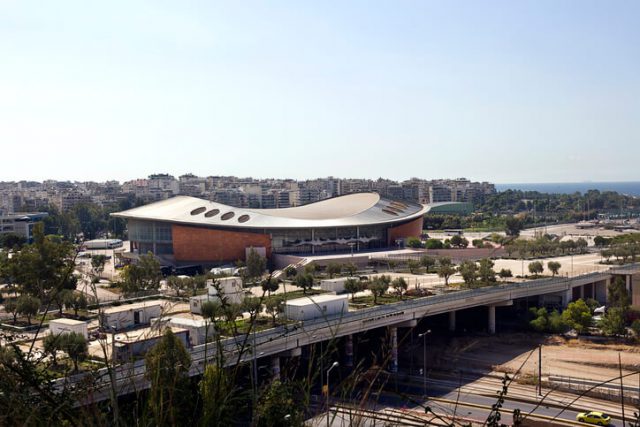
An essential venue for various sports events in Greece is the Athens Olympic stadium. The stadium is a host to one of the biggest sports clubs in the region. The stadium’s foundation was laid on 7 January 1980, and the stadium was opened in 1982. A year after the stadium’s completion, many sporting and cultural events have been held at this stadium.
The stadium was made through a revolutionary construction and involved a prefabricated method. Moreover, the stadium’s capacity is almost 70,000 guests and has become a venue of major sports events. This stadium also organised many guided tours and has a small museum that houses the Olympic torches. Even if you cannot watch a match an event in this stadium, you can always visit the site as a part of a guided tour and explore history.
The stadium is named after the first modern Olympic marathon gold medalist Spyros Louis. The stadium has served as the main stadium during the 2004 Summer Olympics. The stadium was renovated and innovatively positioned with Enerpac hydraulics for this event. In 2007, the 2007 UEFA Champions League final between AC Milan and Liverpool was also hosted in the same stadium.
Stadium Capacity: 74,500

The Millennium Stadium is a highly acclaimed stadium based in Wales, also known as a Principality Stadium. This stadium is the Home of the National Rugby union team and has also held national football matches. Initially, the stadium was built to hold the Rugby World Cup 1999, but it has also been used to host social events such as the Tsunami Relief Cardiff.
Between 2001 and 2006, the stadium hosted the FA Cup, Football League play-off, and league cup. Moreover, the football matches of the Summer Olympics in 2012 were also held in the same stadium. Currently, the stadium is owned by the Millenium Stadium Subsidiary company of the Welsh Rugby Union (WRU). The stadium’s inauguration was held on 26 June 1999, and the first major event held there was a Rugby match between Wales and South Africa.
Millennium Stadium is the largest stadium in Wales and the fourth largest in the United Kingdom. In terms of the stadium with a fully retractable roof, this stadium is the second-largest stadium in the world. The stadium has been listed in the category four stadium by UEFA and was also chosen for the 2017 UEFA Champions League final. When the Welsh Rugby Union announced a 10-year sponsorship deal with the Principality Building Society, the stadium was renamed a “Principality Stadium”.
Stadium Capacity: 72,698
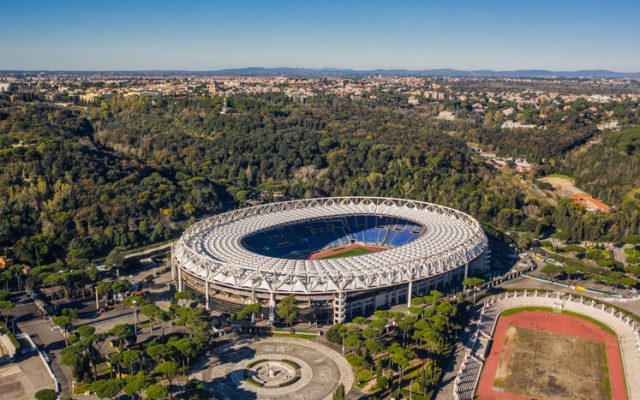
With a seating capacity of seventy thousand, Stadio Olimpico is the largest sports facility in Rome, Italy. The stadium is located within the Foro Italico sports complex, while the National Olympic Committee owns the building. The stadium is exclusively used for football and is a home stadium of the Roma and Lazio football clubs.
The stadium was rebuilt for the 1990 FIFA World Cup, and the final of the tournament was also hosted there. The stadium is also dedicated to sports, musical concerts, and other Olympic events.
Over the years, the stadium has undergone several renovations. The major restyling of the stadium began in 2007, and a major plan to restyle the design was laid down to conform to the UEFA standards. This work was completed in 2008, and it established a standard structure with improvements in security and dressing rooms. Contemporarily, the stadium has a current capacity of over seventy thousand persons.
Stadium Capacity: 69,250
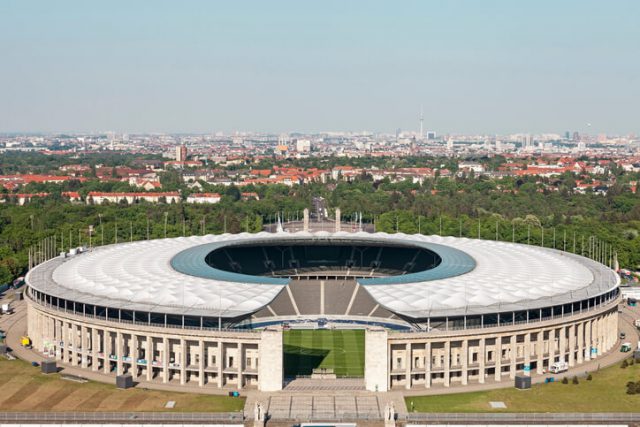
A famous stadium in Germany is the Olympia stadium which was initially built for the 1936 Summer Olympics. This stadium is a part of Olympia Park Berlin and has a capacity of over seventy-four thousand seats. This sitting capacity makes this stadium the largest Stadium in Germany for International football matches.
The Olympiastadion is a part of category four of UEFA and is one of the world’s most prestigious venues for sporting and entertainment events. Besides being famous for Athletics, the arena has built a football tradition and has been a home of Hertha BSX since 1963. The stadium has the honour of hosting three matches of the 1974 FIFA World Cup. Moreover, each year, the DFB Pokal final match is also held at the same venue.
The stadium has also served as a host for the 2011 FIFA Women’s World Cup and the 2015 UEFA Champions League final. The stadium was also used in 1936 to annually celebrate the King’s or Queen’s official birthday celebrations. Furthermore, in 2011, the venue hosted the World Culture Festival organised by Art of living, where more than seventy thousand people mediated for peace. In short, this is not just a football stadium but also holds a major significance for the history of Germany.
Stadium Capacity: 67,829

Termed as one of the most modern stadiums globally, Wanda Metropolitano is a home ground for Atletico De Madrid and can host around sixty-eight thousand people. The stadium is well connected by metro to the city centre and holds large-scale concerts. There is a fascinating museum in the stadium too which is open to the public.
The stadium was inaugurated in September 2017 near Adolfo-Suarez Madrid Barajas Airport. In 2019, the Champions League Final between Liverpool and Tottenham Hotspur was hosted. This new stadium has also become a venue for large-scale concerts, including Bruno Mars, Iron Maiden, and Ed Sheeran.
There is also an Atleti territory where the visitors can delve into the club’s history and its values. With the help of leisure and entertainment activities, an immersive experience is provided to the audience.
The match ticket in this stadium can be purchased either online or at the ticket office in Wanda Metropolitano commercial street. Online purchase of the tickets will have an exclusive reduced price.
Stadium Capacity: 67,394
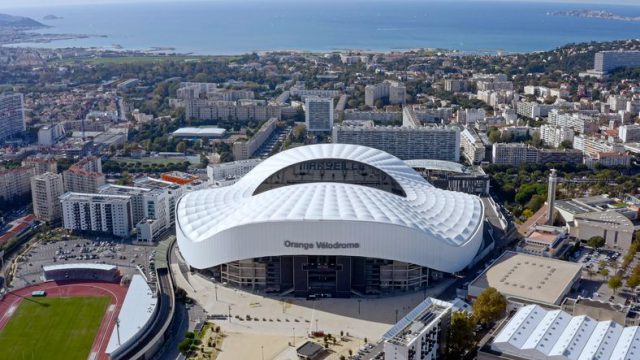
Stade Velodrome is a multi-purpose stadium in Marseille, France, and the Olympique de Marseille football club is home ground. The stadium’s inauguration was held in 1937, and it was also selected as a venue for the FIFA World Cups in 1938 and 1998. Furthermore, in 1960, 1984, and 2016, UEFA European Championships were also held in the same stadium.
The Stade Velodrome is the largest stadium in France. With a capacity of over sixty-seven thousand, the stadium is extensively used by the national rugby union team of France. RC Toulon rugby clubs also host their matches on the same field.
The undulating fibreglass roof of Marseille’s football stadium has been designed by the French SCAU, and they have also helped in extending the stadium’s capacity. Moreover, its figure has been beautifully designed to protect the structure from harsh weather. Although the original structure was designed by French Architect in the 1930s, SCAU renovated it in the 2000s and extended its sitting capacity. The stadium is four kilometres from the Old Port of Marseille.
Stadium Capacity: 67,144
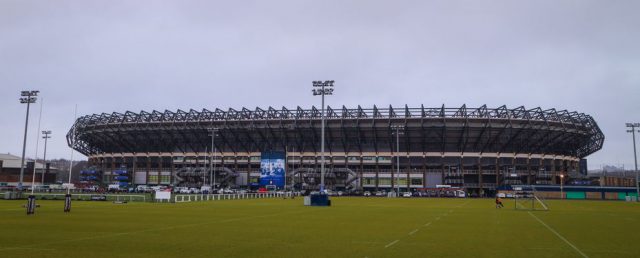
A popular name of the Murrayfield Stadium is Murrayfield. It is in the Murrayfield area of Edinburgh, Scotland. It has a seating capacity of over sixty-seven thousand people, making it the largest stadium in Scotland and the fifth largest in the United Kingdom.
The stadium is the Home of the Scottish Rugby Union and is used as a venue for Rugby Union. Although the stadium is primarily for rugby, it has hosted the American football rugby league and association football matches. Numerous musical concerts are also held in this stadium, apart from these sports events.
Murrayfield stadium also holds historical significance. During World War 2, the ground of Murrayfield was offered to the nation and was used as a supply depot. During the war, armed forces managed to arrange two matches each year. The historical attendance of the stadium was witnessed during the Five Nations Championship when Scotland defeated Wales.
Murrayfield is located next to Murrayfield Ice Rink and is close to Edinburg Zoo. Tourists worldwide visit this iconic stadium and get glimpses of their favourite matches each year.
Stadium Capacity: 64,642
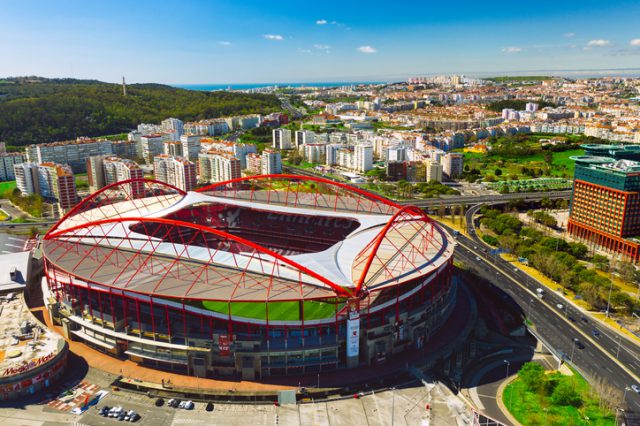
Officially named the Estádio to do Sport Lisboa e Benfica, it is the largest stadium in Portugal that was first opened in 1954 with 120,000 people. But later in 2003, it was rebuilt and opened with an exhibition match between Benfica and Nacional, an Uruguayan club. Designed by HOK Sport, the stadium’s seating capacity was reduced to 64,642 but still remains the biggest in Portugal.
It is one of the biggest stadiums in Europe by capacity and falls in the UEFA category four stadium, which means it can host games in the playoffs of the qualifying stage or any main competitions. The venue also hosted three group matches during the Euro 2004 Championships and the quarter-final between Portugal and England, the final between Greece and Portugal, and the 2014 Champions League Final between Real Madrid and Atletico Madrid.
The current home ground of S.L. Benfica was chosen to be the most beautiful stadium in Europe by L’Equipe, a French newspaper.
Stadium Capacity: 55,634
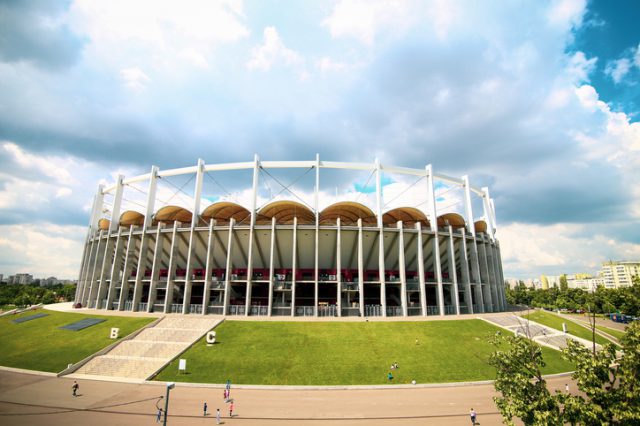
Arena Nationala, generally known as the National Arena of Romania, is a retractable roof stadium built on the site of the previous national stadium. It was officially opened in 2011 with the Euro-qualifier match between Romania and France. Since then, FC Steaua has used the stadium for high-profile league matches, and since 2015, all their home games have been played at the stadium. In contrast, from the start of the 2012/13 season, Dinamo has been playing their home league games at the stadium.
With a seating capacity of 55,634 people, it is the largest stadium in Romania, with a retractable roof that covers the playing surface. Arena Nationala is a UEFA category four stadium and has hosted the 2012 UEFA Europa League final that brought 52,347 people to the stadium. The stadium reached the highest audience at the 2014 FIFA World Cup qualifying match between Romania and Netherlands, bringing 53,329 spectators.
It is the home ground of the Romanian national team and hosted the 2012 Europa League final between Atletico Madrid and Club Athletic. Keeping its great legacy, the stadium will host three group matches of the UEFA Euro 2020.
Stadium Capacity: 51,117
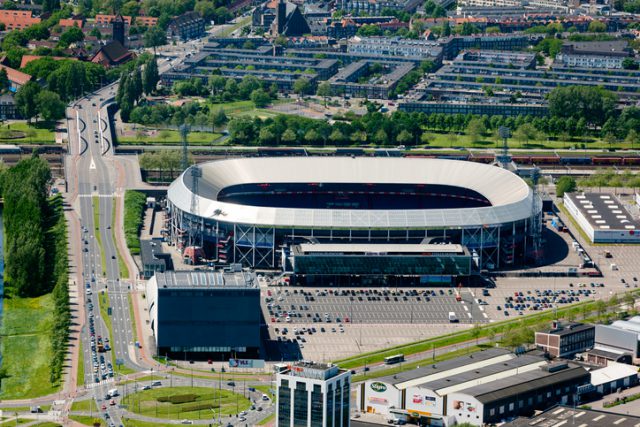
The Dutch Stadion Feijenoord, better known as De Kuip, ‘the Tub’ takes its name from the local neighbourhood and the team. The stadium was first built in the 1930s to give Feyenoord a home ground and a world-class stadium. The stadium’s original capacity was 64,000, which was increased to 69,000 and then converted to all-seater 51,117 seats in 1994.
For hosting the UEFA Euro 2000 finals, it was heavily restored and renovated to become one of Europe’s best stadiums. During the Euro 2000, three group matches, the quarter-final between Holland and Yugoslavia and France and Italy, were played here. De Kuip has been the Netherlands national football team’s home ground and has hosted more than 150 international matches.
Stadium Capacity: 38,065
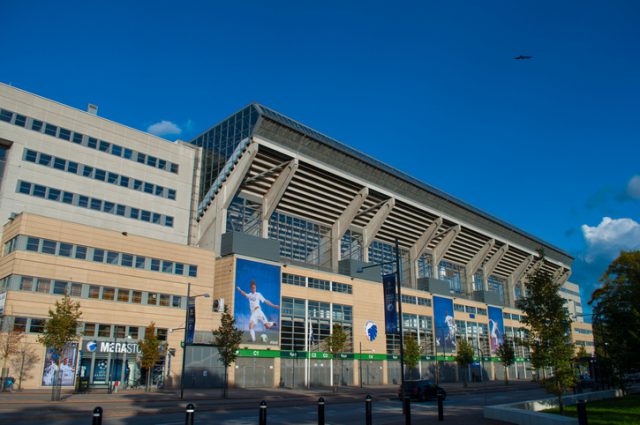
Parken Stadium, generally known as Telia Parken, was built in 1992. Features a retractable roof with a maximum capacity of 38,065 people. It is the largest stadium in Denmark and the national football team’s home. It is built on the location of the previous national stadium.
Parken hosted the Cup Winners’ cup final between Arsenal and Parma in 1994 and the UEFA Cup final in 2000 between Galatasaray and Arsenal. In addition, Parken stadium will host three group matches and a round of 16 games of the UEFA Euro 2020.
Wondering how to watch the Euro matches, share the madness with friends, and still follow COVID-19 guidelines? Everyone in the UK and Europe is crazy about their teams, and even a single encounter between them can make things roll for many of us. If you want to share the joy with your friends and family while moving across the continent with every match, you’ve come to the right place.
We, too, are excited for Euro 2020; therefore, we’re offering 50 per cent off on all our best national and international calling plans. So, use Talk Home to savour the best roaming rates if you’re going to Copenhagen or Bucharest to enjoy the league matches. Nevertheless, our national plans can be the best fit if you’re looking forward to enjoying the finals at the Wembley stadium.
Similarly, high data charges while moving across Europe can leave a dent in your wallet, which is why you should consider saving your data .
To save you from any inconvenience, we at Talk Home offer super saver data plans . If you’re moving from city to city with every match, you would love to share the vigour and joy with people on the internet and live stream either on YouTube and Facebook or post moments on Instagram feed.
Talk Home goes everywhere with you without any border limitations. Taking action and passion across destinations, you can share your sentiments with the ones you care about and the ones following you on social media.
We wish you an energetic and joyful football season. Stay safe, happy, and connected with Talk Home by your side.
How to Transfer My Mobile Number to Another Network
Reconnecting With Old Friends - A Social Conundrum
Olivia Gordon
Always taking pride in my African ancestry, I ended up settling in London a few years ago and joined Talk Home as an Editor. Ever since then, I’m in love with plentiful rain, aromatic tea and fast paced tech world, sharing what I learn with the world through blogging.
You may also like

Free Wi-Fi Hotspots in the UK – All You Need to Know
Moving to the uk: a complete guide, traveling to qatar – everything you need to know about the fifa world cup 2022, reconnecting with old friends – a social conundrum, post a comment cancel reply.
Your email address will not be published.
Save my name, email, and website in this browser for the next time I comment.
- Bayern Munich
- Borussia Dortmund
- Leeds United
- Manchester City
- Manchester United
- Newcastle United
- Real Madrid
- Tottenham Hotspur
- Premier League
- Champions League
The 13 grounds you must visit on a European football road trip
Being in Europe means being on the doorstep of a bottomless pit of opportunity to catch some truly brilliant football matches, across cities packed with culture.
While there are some truly mesmerising football stadiums and genuine bucket list pipedreams of stadiums we’d love to visit worldwide, the advantage that a European road trip has is, well, exactly that – the close proximity allows for much more efficient groundhopping if you’re putting together a mini-road trip of sorts.
Taking into account factors such as beautiful stadiums, atmospheres and fan culture, good transport links and the things to do in each city, we’ve pulled together a list of 13 stadiums you ought to try and watch a game at on a European road trip.
In a bid to try and create as much variation as possible, we’ve done our best to limit this to one stadium per country, with a few exceptions.
Santiago Bernabeu – Madrid
Starting with the obvious ones, there is simply no excuse not to visit the Bernabeu if you find yourself in Spain – even more so now it’s been renovated.
Home to perhaps football’s biggest club, seeing a Real Madrid game is a genuine bucket list experience. Superstars galore in an institution so rich in history that it hurts.
It’s also just as easy to catch Real Madrid Femenino at the Alfredo Di Stefano while there, and Madrid is full of things to do as a tourist.
A no-brainer.
Camp Nou – Barcelona
Europe has an endless supply of brilliant football to the point where you could make a few weeks of just watching several games within one country, which is why this list is difficult to narrow down.
If you’re in Spain, though, and have the chance to visit both Barcelona and Madrid, visiting both stadiums simply has to be done. The Camp Nou is undergoing heavy renovations right now, but when it’s done, it’ll be an unmissable experience similar to that of the Bernabeu.
Away from the football, Barcelona is also a stunning city.
San Siro – Milan
Both Milan clubs have been keen to move out of San Siro – also known as the Giuseppe Meazza – for several years now, thus it’s hard to know exactly how long we’ve got left to visit one of football’s holy grails before it’s potentially knocked down.

READ: I watched Inter Milan at the San Siro & discovered the meaning of life
Stade Velodrome – Marseille
An impressive 67,000-seater stadium in the South of France, the Velodrome looks like something from the future and is home to one of the most ferocious atmospheres in European football.
Marseille are a club steeped in history with nine Ligue 1 titles, 10 Coupe de France trophies and one Champions League, and their fans are notoriously passionate – sometimes too passionate.
Opened in 1937, the Velodrome has been a host of two World Cups and is also regularly used by France’s national rugby team. Away from the sport, there’s plenty to do in Marseille, a picturesque port city with lots of lovely architecture, good food and great weather.
Stadion An der Alten Försterei – Berlin
Germany is yet another nation where you’re essentially spoilt for choice when it comes to brilliant cities for football. Berlin, however, should be a priority.
The capital is swimming with fascinating history, plenty to do and two Bundesliga teams to enjoy watching. Watching Hertha is an option, but we’d prefer to go southeast and watch Union Berlin at the Stadion An der Alten Försterei.
A tightly-packed stadium surrounded by greenery, it holds just over 22,000 fans and has those all-important standing terraces which improve an atmosphere tenfold. It also has an exceptionally unique look and is easy to get to.
Affordable and one for the hipsters among us.
Signal Iduna Park – Dortmund
If you want a more well-known German football experience and are willing to spend a little more money on a ticket – merely due to such high demand – then a trip to Dortmund for a game is a no-brainer.
Home to the famous Yellow Wall, the Signal Iduna Park – also known as Westfalenstadion – champions one of the most impressive terrace-standing sections in the game behind the goal and is an absolute marvel.
Affordable beers, great food and the best part is that you can take those affordable beers to your seat.
Tickets might be a little harder to come by – especially if you want to be in the atmosphere sections – but if you can snag some, then do.

Some view, that.
Johan Cruyff ArenA – Amsterdam
A true footballing institution within a city where it’s impossible to be bored, a stop in Amsterdam coupled with a trip to the Johan Cruyff ArenA is the dream.
They might not be the footballing powerhouse that they once were, but to hear Ajax fans on home turf, those iconic shirts and the young guns taking their chance in such an impressive stadium is a must.
And like we’ve just alluded to, there’s much more to Amsterdam than just the football.
Fortuna Arena – Prague
While it doesn’t stand out among the big flashy names, the Czech Republic – and Prague in particular – is a hidden gem for a European football fix on a budget, and you get the full experience.
One of the game’s most underrated derbies is contested in the capital between Slavia Prague and Sparta Prague. It doesn’t stop there, though, with as many as six teams based in Prague.
We’ve highlighted Slavia and the Fortuna Arena, a 21,000-seater stadium east of the centre which has famous ultras – and a McDonald’s drive-thru built into the side of the ground. Really.
Don’t waste your time in the McDonald’s, though, get lost in the city centre and the various bars and restaurants. You won’t struggle.

The McDonald’s drive-thru in full view…
Old Trafford – Manchester
There is a very real possibility that Old Trafford as we know it will no longer exist in the not-too-distant future. That is an absurd thought and all the more reason for a trip to Manchester to watch Manchester United.
The Red Devils are a far cry from the force that they once were, but you’ll struggle to find someone who doesn’t concur that Old Trafford – when in full voice – is one of the greatest grounds ever to be stood in. Historic.
A weekend in Manchester around that isn’t bad, either. Bring a waterproof and get lost in bars, or take a train to any of the surrounding cities or more rural areas.
Anfield – Liverpool
From a stadium pending an overhaul to one which is coming out of a fantastic renovation phase, Anfield is merely down the motorway from Manchester and another brilliant bit of footballing history that’s a must for anyone wanting the Premier League experience.
Much like Old Trafford, snagging a ticket for a game at Anfield will be difficult – and/or cost you a pretty penny – but if you can get one, don’t hesitate.
Only a stone’s throw away from Manchester on the train, Liverpool is a brilliant city for a mini-break. If you like Manchester’s options, you’ll love Liverpool’s.
Henryk Reyman Stadium – Krakow
A brilliant holiday destination and always affordable, Krakow is just one of several brilliant cities to visit in Poland.
The national team play in Warsaw, another excellent city, but for a combination of football and good times then a trip to the Stadion Miejski im. Henryka Reymana – home of Wisla Krakow – is a brilliant shout for the football fix.
A club steeped in history, the stadium looks brilliant. It’s tightly-packed and the stands sit right on top of the pitch. Krakow is also home to excellent food, cheap beer and plenty of culture.
Architecture, castles, the old town, an amazing square and museums – just to name a few recommendations.
Parken – Copenhagen
You might’ve noticed Copenhagen making a splash in the Champions League in recent times, one particularly big splash being their 4-3 victory at home to Manchester United in November 2023.
They did so at the ever-electric Parken, which has become home to some of the most impressive fan displays in recent times.
Compact, noisy and passionate, it’s a serious insight into just how good European football can be away from the big names. Just be sure to bring plenty of spends and your nicest clothes – the capital of Denmark is one stylish city.

A proper showing.
Besiktas Stadium – Istanbul
We’re finishing off this list in Turkey’s capital, where again you’ve got the pick of the bunch between several giants.
While Galatasaray or Fenerbahce might be the most obvious choice, Besiktas are a club who boast equal star power in the players they attract and their new stadium opened in 2016, making for a brilliant experience right on the Port of Istanbul, for even better views.
A bustling city with amazing mosques and museums as well as bars, food and tourist activities, it’s a trip that has it all – and one you can do at a fair price.
READ NEXT: 11 of the most iconic stadiums that we wished still existed: Highbury, Upton Park…
TRY A QUIZ: Can you name the last 20 players to break the world transfer record?
- Best Hotels Near Major Football Stadiums
- Where to Buy Liverpool FC Football Tickets
10 BEST FOOTBALL STADIUMS IN EUROPE YOU SHOULD CONSIDER TO VISIT:
- Where Should You Buy Chelsea FC Football Tickets?
- Should You Use Stubhub for Arsenal or Chelsea Tickets? We’re Glad You Asked!
TicketNetwork.com – pros and cons full review
- Where to buy Arsenal tickets?
PostingTravel.com
Football~Europe 2022. Well! who doesn’t know the connection. A game that is deeply engraved in the souls of the Europeans. Some called it:
“ The unofficial religion of Europe”
It’s not wrong. Football its more than just a game it’s what the Europeans believe. A large number of devotees are present in every street and every city of Europe with their zealous and spirited heart awaiting to see their luminary figures live in their home town.
Owning to such a large number of followings and fans it is not a surprise to have a large number of amphitheatre and fields in almost every city of Europe. At least, the major ones.
But in this array of stadiums, there are some tremendous, remarkable and exceptionally built stadiums that are loaded with action packed episodes. That holds massive memories of wax and wane, sorrow and glee that still smells fresh.
Here is a list of some most insane, famous and beautiful football stadiums located in the land of palaces and castles, Europe:
10. OLD TRAFFORD:
Being the biggest club stadium of Great Britain. Old Trafford football stadium is loaded with a number of remarkable memories of bittersweet.
Built as a all enclosed stadium with a capacity for around 44,000 loyal fans this majestic theatre costed around 30,000,000 GBP.
This field was officially opened on 19-Feb-1910 for match between Manchester and Liverpool. Now this “THEATRE OF DREAMS’” is the home of Manchester united.
The Trafford stadium is just the perfect combination of old yet modern building which has been renovated in 2007 for a much bigger and better version holding a capacity now of 75,730 peoples with a much comfortable and opulent experience.
Thanks to the management, who have managed to maintain its significant and superior position in the world of football being a 5 star UEFA rated stadium.
Travelling to Manchester while in the UK is highly recommnded, as the Manchester Hotels cost is quite relatively cheap.
Looking For Old Trafford tickets? You can use the link below to find your ticket.
9. Ülker Stadyumu :
Previously known as Fenerbahce stadium on the name of its owner has gone through a number of extensive rebuilding and renovation for a better and bigger approach.
Now, called Ülker Stadium is one of the most majestic and legendary stadiums in Turkey located in the heart of Istanbul, sukru is a must visit place for the ones who loves the game with the depth of their heart.
Costing around 70 Million euros at the time of built holds a seating for 47,834 of its loyal fans. Each light was completely renovated by the year 2006 which then resulted in a traditional yet modern looking stadium.
8. EMIRATES STADIUM, London :
The Emirates stadium also known as the Highbury Arsenal stadium was built in 2006 is now an icon of England. Being one of the most luxury stadiums in the world it costed around 390 million GBP st the time of built , it can provide a comfortable and luxurious seating for over 60,260 people.
No doubt! That many remarkable matches has taken place in the past in this glorious and majestic stadium and are still loaded with memories. For this reason it is affectionately known as:
“ The home of football”
This same home of football is also the “home of Arsenal Club”. In 2004, the sponsorship deal with Emirates Airlines confirmed the stadium to be of its name.
Anyway, this stadium is absolutely the Mecca for the fans of Arsenal all around the world. for more information please visit our “ where to buy Arsenal tickets ” article.
Looking For Emirates stadium tickets? Use the link below to find your ticket.
7. CELTIC PARK, Glasgow :
Being the largest in Scotland and 8 th largest football club in the United Kingdom. The Celtic park, not surprisingly is the jewel of Europe’s crown.
Celtic park affectionately known as “THE TIMS” nowadays worth around 81.09 million GBP and obviously , is the home of celtic Football club. Celtic park is also one of the most memorable , majestic and prestigious icon of Glasgow loaded with a lot of memorable and historical events. Officially opened in 1888 was completely renovated in 1990 except a single main stand and has now a capacity for 60,411 people with a recorded highest attendance of 92,000 in a match against Rangers
It was originally designed by Archibald leitch and is a representative of Celtic cultural heritage and for any football fan it should be a must visit site.
Looking to purchase some Celtic Park tickets? Use the link below to find your ticket.
6. ALLIANZ ARENA, Munich :
With a majestic and eye-catching design “The Allianz Arena” is obviously one of the most beautiful stadium in Europe.
Built with a construction cost of 340 million euros has a capacity for almost 72,000 of its fans. At the time of built a referendum of 65.8% was in favour while 34.2% stands up against to it.
Anyway! This amphitheatre with a 38,000 meter sq roof area is one of the most ionic football stadiums of 21 st century. Being the first full exterior colour changing stadium is the home of Bayern F.C and an honour for Germany.
For Allianz Arena Stadium tickets Use the link below.
5. ANFIELD STADIUM, Liverpool :
Not as large as the Old Trafford, but still holds a number of remarkable memories including the win of Liverpool against their rival Chelsea in 2005 after an incredible match between them.
Once was the home of Everton is now Liverpool F.C own territory. Being built in 1884 in the city where football is the greatest passion which after renovation in 1994 can hold a capacity of 54,074 devotees. The Reds’ is currently operated by Liverpool football club. if you want to visit live, you can read our Liverpool tickets article.
Dream to witness the history ? Use the link below to find tickets for any Anfield stadium event.
4. WEMBLEY STADIUM, London :
The recent Wembley version features a wonderful and ionic arch to hold a part of roof up. The new Wembley was built in between 2003-2007 has a total capacity of 90,000 persons. Being the most ionic stadium in the world it costed around 789 million GBP at the time of build which would be now around 1.17 billion GBP. A highest attendance record of 89,974 is the largest in Europe.
This majestic field is the home of England National Football Team and is located in one of the most convenient part of London . Its also used for large concerts.
However, this field holds a massive number of memories and has successfully hosted two champions league final in 2011 and 2013 and will also stage for 2020 euro cup final.
Looking to purchase some Wembley stadium tickets? Use the link below to find your ticket.
3. SAN SIRO, Milan:
Doubtlessly, the pride of Italy, San Siro is a must visit destination for the followers of football in this live world. Being one of the largest stadium in Europe it is also one of the greatest, having a capacity for around 81,000 of its devotees. It was completed in 1926 after the hard work of hundreds of workers and engineers costing around 650 million euros.
This awesome field is now the home of Inter Milan and is owned by the municipality of Milan.
Thanks to the architects Alberto Cugini and Ulisee Stacchini who designed this and it took 13 months to make their idea come to life. With an area of 35,000 sq San Siro has hosted some of the most important matches and leagues.
For San Siro tickets please click on the link:
2. Santiago Bernabeu :
Slightly smaller than Camp Nou, the insane Santiago Bernabeu located in the beating heart of Madrid is another honour for Spain.
With a comfortable arrangement for about 85,454 people to enjoy the match. It costed around 1,732,943 euros to build it which was completed in 1947. but indisputably it is more majestic and good looking than the camp nou and has gone through number of renovation including in 1982 for the world cup.
It also holds the title of 2 nd largest in Spain and all this is the home of the famous REAL MADRID and has successfully hosted many memorable matches including European cup and UEFA Champions league.
Search your Tickets to Santiago Bernabeu Stadium :
1. CAMP NOU, Barcelona:
Designed by Francesc Mitijans and Joseph Soteras, a masterpiece that costed around 1.73 billion euros is absolutely the largest in Spain and so the whole Europe with a gigantic capacity of 99,354 football fans from all over the world and still they are aiming to touch the 100,000 all-seated capacity record.
Actulally it was completed after 3 years of extreme labour and hard work in 1957. Camp Nou generally mean:
“ THE NEW STADIUM ”
Being the home ground for F.C Barcelona it has hosted some of the finest teams. At the time of 1982 world cup it was capable of holding 122,000 until standing places were removed.
However, it has not a much attractive external appearance but is still a marvel for the whole Europe.
Need Tickets to CAMP NOU Stadium?you can search your options via the link below :
Related Posts
MORE SECTIONS
- Competitions
- Fan Network

- Scottish Premiership
- Premier League
Top 30 football stadiums in Europe ranked, including homes of Liverpool, Everton and Real Madrid
Just who can lay claim to having the best ground on the continent?
- Published : 10:01, 30 Nov 2018
- Updated : 10:11, 30 Nov 2018
Just how do you rate a football stadium? Is it based on size? It is atmosphere? Facilities? History? Or something more.
Regardless of your criteria, most people seem to accept Tottenham's new - heavily delayed - stadium will be one of the best in the world.

It has a number of excellent features, including a huge single-tier stand, tailored acoustics and a cheese room and microbrewery.
When it finally opens, Spurs' ground looks set to become one of the best regarded around.
However, it is not yet open - and won't be until the new year - so who currently holds the crown for having the best stadium in Europe?
When will Tottenham's new stadium open?
- Due to a number of issues, Spurs' new ground has been delayed since the planned opening date of September 15.
- The pitch has now been laid and the famous Golden Cockerel installed, and an event held last week showed just how the stadium will look on a matchday.
- However, Spurs have confirmed they will play all their matches for the remainder of 2018 at Wembley, and they've also agreed a deal to use the national stadium for the rest of the season if required.
- Nonetheless, the north Londoners remain confident they will be playing at their new stadium before the end of 2018/19.
talkSPORT.com has rated the 30 best stadiums on the continent, and you can see the full ranking, from 30th to first, below...

Built in 1876 as an athletics stadium, Chelsea were founded in 1905 to give the ground a tenant when it was converted to a football stadium. In the 1990s the Bridge underwent a complete makeover, being converted from a vast concrete bowl with terracing, to the compact 41,798-capacity all-seater it is today. Situated slap bang in the middle of a prized area of west London, Stamford Bridge is hemmed in by two train lines and a main road, giving it a unique metropolitan feel. Plans have been made, then put on hold, to convert Chelsea's home into an ultra-modern arena.

Built in the 1950s, the Luzhniki hosted the 1980 Olympic Games and Manchester United's 2008 Champions League final defeat of Chelsea. It has staged CKSA Moscow, Torpedo Moscow and Spartak Moscow matches, and underwent major renovations ahead of the 2018 World Cup - with the final held at the Moscow ground. The stands have been brought as close as possible to the football pitch and modified, meaning their incline is lower-pitched. Crowd capacity has been raised from 78,000 to 81,000 as well, while the arena's roof can be turned into a giant video screen. The stadium's darkest hour came in 1982, when 66 people died in a stampede at a Spartak Moscow UEFA Cup game.

This stadium makes our top 30 thanks to its stunning location and ingenuity. With a capacity of just 18,523, it's not relatively compact, and it's not exactly a cauldron as tenant club Monaco don't draw particularly passionate crowds, but to fit a ground into this location makes for a spectacular stadium. So little room was there to build it in 1985, that most of the facilities are located underneath the stadium, including the car park.

Opened in 2012 as a replacement for the Rasunda Stadium (which hosted the 1958 World Cup final), the Friends Arena boasts a retractable roof and is located just north of Stockholm city centre. It plays host to the Swedish national team and Allsvenskan club AIK. It also staged the 2017 Europa League final, between Manchester United and Ajax.

The new Estadio da Luz – aka the Stadium of Light – holds 65,647 and was built in time to host the Euro 2004 final. Home to Benfica, it also hosted the 2014 Champions League final. While impressive and modern, it doesn't have the aura that surrounded the club's old Stadium of Light, which once held around 135,000 fans and was the largest stadium in Europe in the 1980s and early '90s. It also looks rather similar to Arsenal's Emirates Stadium.

Better known as 'De Kuip' ('The Tub'), this historic, atmospheric stadium has been around since 1937. It was extensively renovated in 1994, with the stylish roof added, and has hosted 10 European club finals, including the 1982 European Cup final, as well as the final of Euro 2000.

Home to West Ham United, this may seem a controversial inclusion as the London Stadium formerly the Olympic Stadium has been criticised for not being suited to football. It was renovated extensively after the 2012 London Olympic Games, with retractable seating installed over the athletics track and a new roof put in place to cover all seats. The result is that there is a greater distance between the stands and playing area than has traditionally been the case at an English football ground. But the view from most parts of the stadium is perfectly fine, and it represents a huge upgrade for West Ham on their old, albeit beloved, Upton Park ground. The floodlights in the new stadium alone are absolutely magnificent, and don't believe the naysayers this is an impressive stadium - just maybe not the perfect football stadium.

Constructed in the early 1990s on the site of the historic Idrætsparken stadium, which itself was built in 1911, the Parken is home to FC Copenhagen and the Danish national team. With its traditional four separate stands, it's what you might call a 'proper football ground', although the new 'Superbest stand' – built in 2007 to replace the 'D end', which was originally the old stadium's main stand – has spoilt the Parken somewhat, reducing the capacity from just over 42,000 to 38,000, in order to incorporate corporate boxes. Arsenal fans have mixed memories of Parken, having seen their club win the 1994 Cup Winners' Cup final there, but lose the 2000 UEFA Cup showpiece.

Newcastle United's home ground changed almost beyond recognition between 1993 and 2000, going from a ground with ageing terraces and a capacity just above 30,000, to a modern 52,000-all seater stadium. That development was extremely lop-sided, with the Main Stand and Leazes End towering above the Gallowgate End and, particularly, the East Stand, behind which stands a row of Georgian terraced houses that restrict any expansion to the stadium on that side.

With a capacity of 59,186, Lyon's impressive new stadium - which, without sponsorship, is called Parc Olympique Lyonnais - was only opened in January 2016 and hosted matches at Euro 2016, including a semi-final. It looks impressive inside and out.

Originally opened in 1908, Fenerbahce's stadium has undergone extensive rebuilding along similar lines to Borussia Dortmund's Westfalenstadion, with each stand completely replaced in a renovation that finished in 2006. The result is a modern, but traditional-looking ground that holds just over 50,000 fans. It's effectively a new stadium, but one that boasts much more history and character than the new home of their fierce rivals, Galatasaray, who moved into the Turk Telekom arena in 2011. Unlike the latter stadium and Istanbul's other large ground, the unloved Ataturk (scene of the 2005 Champions League final), the Sukru Saracoglu is located in the beating heart of Istanbul, rather than stuck on the outskirts.

Some people may be surprised to see Goodison included on this list, but while it is undoubtedly dated, that is also its strength. Modern football fans may demand plush seats, but with brand new stadiums often come a complete lack of soul. Goodison could never be accused of lacking character, nestled snugly among streets of terraced houses and with a church between the corner of the main stand and Gwladys Street end. Two sides of the stadium were designed by the famed football ground architect Archibald Leitch – a man responsible for many of the most famous grounds in British football – identifiable by his trademark balcony trusses. Everton are understandably keen to move with the times and modernise their home ground, but for the diehard Bluenoses, the prospect of moving to a brand new stadium leaving the area to that lot from across Stanley Park fills them with dread.

Home to Hertha Berlin, this is the only stadium on our list with an athletics track, because athletics tracks are never good news for football grounds. But this stadium has a memorable appearance, featuring an open-end that dramatically frames a bell tower in the park outside the stadium, as well as marking where the 1936 Olympic torch was positioned, and housing a tunnel that formed a dramatic entrance for marathon competitors at the Games. The 1936 Olympics were tainted by their Nazi associations, but fortunately this stadium stands as a monument to much more. After being renovated and given a new roof, it hosted the 2006 World Cup final and was the venue for Barcelona's 2015 Champions League triumph. Oh, and Usain Bolt set the world 100m and 200m sprint records on the track, which is distinctively blue, so we can just about forgive its presence.

Frankly, we preferred Arsenal's old Highbury Stadium for character, but the Emirates Stadium helped set the standard for new arenas in English football. Opened in 2006, it holds 60,000 fans, all in comparative luxury with padded seating. Its middle, corporate tier is famed for filling up late and emptying early, as pampered Gooners indulge in slap up meals before dashing off back to the home counties. But hats off to Arsenal for managing to move around the corner, building a massive new stadium in a heavily-built up part of north London, just a stone's throw from their old ground. Rather that than moving miles away to, say, Plumstead.

Opened in 2001 and currently better known by its sponsored name (its former title was Arena AufSchalke), Schalke's new home was, unlike Arsenal's, a vast improvement on their old place, the Parkstadion, which was a hideous concrete bowl. By contrast, the Veltins-Arena is a more intimate affair, despite boasting a capacity of 62,271. And look, it's got terracing! Yes, brand new German stadiums were built with safe standing, which makes it even more appealing. And then there is the retractable roof and pitch, which can slide outside in just four hours, to allow the grass to grow in more natural conditions and prevent it from being damaged when concerts are held inside the stadium.

The largest football stadium in Scotland, with a capacity of 60,411, Celtic Park was transformed in the 1990s from an oval ground with vast terracing to the all-seater stadium it is today. Only the Main Stand remains from the old design, and it is dwarfed by the new stands which form a continuous loop on three sides of the stadium. But this oddity gives the ground a certain charm, as well as a link to the club's historic past. Overall, Celtic did a great job of modernising their stadium, especially considering the North Stand is squeezed into a tight space, with a cemetery behind. Celtic Park has certainly risen to the occasion on some memorable European nights since.

When Italy hosted the 1990 World Cup it was lauded at the time for its array of modern stadiums, including the brand new Stadio delle Alpi in Turin, into which Juventus moved. But despite playing host to some of the finest Juventus teams ever, the delle Alpi was a horrendous arena, especially thanks to an athletics track that was never used for a major meet, but served to separate football fans from the pitch. So, in 2009 the 69,000-capacity stadium was demolished and on the same site the Juventus Stadium was built, which has since become known as the Allianz Stadium due to sponsorship reasons. Having learned the lessons of the delle Alpi, Juve's new ground is a much more intimate affair, holding just 41,475 fans, and is all the better for it. The stadium hosted the 2014 Europa League final and has been a roaring success for the Old Lady of Italian football.

The old Welsh National Stadium was demolished (save for a small section connected to a neighbouring rugby ground) in the 1990s to make way for the magnificent Millennium Stadium, also known as the Principality due to sponsorship. Completed in 1999, it is known primarily as the home of Welsh rugby, but has proven to be a superb football stadium, too. With its steep three-tier stands on three sides, it is interestingly broken up by a two-tiered North Stand at one end (where the the only surviving part of the old National Stadium backs on to, and helps support, the Cardiff Arms Park club ground behind). Its 74,500 capacity is impressive considering the city centre location, right next to the River Taff, and there is a retractable roof to keep the elements out when necessary. The stadium has hosted six FA Cup finals and various other English league contests, thanks to the closure of Wembley Stadium between 2001 and 2007, and also held the 2017 Champions League final between Real Madrid and Juventus.

The Allianz Arena is a funny one. Arguably the most iconic of the 21st century's new European football stadiums, it literally stands as a beacon – its innovative stadium facade lighting up at night to make it visible for miles. But then it is miles away from anywhere, barely in Munich at all. Bayern moved to the Allianz Arena from the city's Olympic Stadium, which suffered from the running track problem, and there is no doubt their new ground boasts far better sight lines. But while the outside is lit up, inside every seat is grey, making for a rather uniform, dull picture. In fact, take away the light show and it's just another out of town arena. Impressive, but not enough to make its way into the top 10.

Originally built in 1923, Cologne's stadium - also know as the Müngersdorfer Stadion - used to be blighted by that old athletics track problem, but that was cured when it was renovated for the 2006 World Cup. In its place was constructed a fantastic football ground, with towering stands putting 50,000 fans close to the pitch. And it's got standing sections, too.

The biggest club ground in English football, Old Trafford has, unlike most British stadiums, developed over the years with a coherent plan. While most English football grounds were built with four different, unrelated plans on each side of the pitch, by the early 1990s Old Trafford – originally constructed in 1909 – was completed as an all-enclosed stadium with an all-seater capacity of 44,000. By 2007, further development had taken the capacity to over 76,000, although this has dropped slightly since. Only the South Stand remains single-tiered, due to restrictions caused by an adjacent train line. Sir Bobby Charlton called it 'The Theatre of Dreams' and it's definitely one of European football's most iconic venues.

Originally a vast concrete bowl, Ibrox once held over 118,000 fans, but was redeveloped completely in the late 1970s, following a disaster in 1971 in which 66 fans lost their lives. Only the old, Archibald Leitch-designed main stand remained (complete with familiar criss-cross balcony) and as a listed structure, it was cleverly modernised with a new roof and extra tier in the late 1990s. The end result is a 51,000-capacity football ground that combines modernity with tradition and atmosphere.

Opened in 1923, the Mestalla now seats 55,000 fans in its distinctively steeply banked stands. Valencia began construction on a new stadium in 2007, but due to financial issues it has yet to be completed. When you look at the current ground, which is an awesome spectacle when full, you have to wonder why they bothered. And look, it's got a bat on the seats!

When Anfield opened in 1884 it was home to Everton, but for most of its history it's been Liverpool's stadium. The club spent years looking for a new location to build a brand new stadium, but the current owners have decided to renovate the Reds' one and only home. While it may not be as large a stadium as Old Trafford, partly due to it being hemmed in by terraced houses and roads, on big occasions Anfield retains an intimacy that is the envy of most of Europe. This reputation stems largely from the Kop, arguably the most famous 'end' in world football. Formerly a huge terrace, all-seater regulations led to the old Kop's demolition in 1994 and replacement with a new structure. Fortunately, Liverpool rebuilt the Kop as a single-tier stand, holding 12,390 fans but looking all the more imposing as one, unified mass of fans. Recent improvements and renovations have taken the max capacity past the 54,000 mark.

Marseille's fans have a reputation for being among the most vociferous in Europe and now they have a stadium to match their reputation. Renovated for Euro 2016, it now holds 67,000 and features a truly stunning roof.

The largest football stadium in Europe, Camp Nou has played host to some of the finest teams in the history of the beautiful game. Built in 1957, it expanded for the 1982 World Cup, eventually becoming a three-tiered arena at one point capable of holding 122,000 fans, until standing places were removed. Its present capacity is 99,354 all-seated, but this is planned to increase to over 100,000 as the club intend to modernise the stadium completely, addressing the lack of roof on three sides of the stadium and, frankly, unattractive external appearance. For all its reputation, outside the Camp Nou resembles an ugly concrete car park, which seems hardly befitting of the club's glamorous reputation.

With 85,454 seats, the Bernabeu is slightly smaller in capacity than the Camp Nou, but at present it's much more pleasant on the eye. Extensively renovated for the 1982 World Cup, like the Camp Nou over the years it has grown ever higher, with more tiers added. Unlike Barca's stadium, the Bernabeu benefits from a roof on all sides and, like the club's name, feels that little bit more regal.

Second only to the Camp Nou in terms of European football stadium capacity, 90,000-seater Wembley is the largest of Europe's new wave of modern grounds. The old Wembley was possibly the most iconic stadium in the world, but had seen better days when it was closed in 2000. While the new Wembley – which opened in 2007 – may not yet be able to boast the same amount of memorable moments, it is undeniably a magnificent arena. There's not a bad seat in the house and the arch makes it visible for miles around London. Perhaps the only gripes are that the location, on the site of the old stadium, is not the most convenient part of London to get to - as Spurs fans will tell you every week they have to traipse from the east to the west of the capital. Furthermore, the corporate seating is a reminder of modern football's tendency to put cash before atmosphere. Still, it's already hosted two excellent Champions League finals, in 2011 and 2013, and will stage the Euro 2020 final.

Along with the Bernabeu and Camp Nou, Milan's San Siro is a stadium that seems to evoke everything that is grand about European football in the past half century or so. Like a lot of Italian stadiums, there is no doubt that the San Siro is ageing and lacks many of the comforts that come as standard with brand new stadiums. Yet still it remains a marvel. From outside, the distinctive ramps and columns, along with that girder roof (added along with the third tier for the 1990 World Cup), make it look like something that's just landed from outer space. Inside, its imposing, steep stands – holding over 81,000 fans – are breathtaking. The San Siro hosted the 1990 World Cup opening ceremony and has staged four European Cup finals, including the 2016 Champions League final.

In top spot, it's the home of Borussia Dortmund. Built for the 1974 World Cup, up until the late 1990s it was a relatively unremarkable stadium, with a capacity that hovered around the 50,000 mark. Then, following Dortmund's 1997 Champions League success, the Westfalenstadion - as it's traditionally known - began a process of expansion that led to its capacity increasing to 81,359, including the development of the South Stand terrace. Known as the 'Yellow Wall', this bank is the largest terrace in European football, holding 24,454 fans. The standing places can be converted to seats for international and European matches, reducing the stadium's overall capacity to 65,829. Dortmund are now able to boast a superb stadium that marries modernity with fan values and, from being an unsung stadium outside of the Ruhr, the Westfalenstadion is now celebrated around the world as a symbol of the passion football inspires among fans.
Latest Football News

Spurs host Man City in Carabao Cup as Liverpool, Arsenal and Man United learn opponents

Marcus Rashford likened to Ronaldo for 'class' piece of skill during Man United clash

Arsenal starlet instantly creates Carabao Cup history as he breaks 61-year record

Four Arsenal starlets achieve bizarre club first following start in Carabao Cup vs Bolton
- Bayern Munich
- Borussia Dortmund
- FC Barcelona
- Glasgow Rangers
- Inter Milan
- Manchester United
- Newcastle United
- Real Madrid
- West Ham United
GiveMeSport
Europe’s 50 Best Stadiums Have Been Ranked by Study

Your changes have been saved
Email is sent
Email has already been sent
Please verify your email address.
You’ve reached your account maximum for followed topics.
Key Takeaways
- Europe's top football stadiums have been ranked by factors like capacity, ticket prices, and disabled access.
- British stadiums, including Ibrox and the Stadium of Light, make the list, while Manchester United's Old Trafford makes the top five.
- Signal Iduna Park in Dortmund takes the top spot, beating out iconic stadiums like Santiago Bernabeu and Camp Nou.
The beautiful game that is football is enjoyed around the globe, with Europe being a hotbed for the sport. The venues that host some of the biggest games in the continent have been ranked from best to worst.
A study, carried out by James Stagman on behalf of Stasher , took factors such as stadium capacity and average ticket prices into account along with several others. This has led to results displaying the best grounds to visit and soak in the atmosphere that comes with the wonderful sport.
Ranking Factors
The study notes that the factors taken into consideration when attempting to rank the 50 iconic stadiums in order are as follows, with an overall score being generated as a result:
- Stadium capacity (the higher the better)
- Average ticket price (the lower the better)
- Cost of a pint (the lower the better)
- Ease of access (via public transport)
- How good the disabled access is (accessible toilets, elevators, ramps, wheelchair-accessible seating etc.)
- Online reviews (specifically Google ratings)
Every Premier League Stadium Ranked From Best to Worst
Every Premier League stadium for the 2024-25 season has been ranked - including Portman Road, King Power Stadium and St Mary's.
Sunderland's Stadium of Light is a surprise inclusion
The United Kingdom is very well represented within the top 50, with Sunderland's Stadium of Light and Ibrox of Rangers narrowly making the cut. The latter has been home to many special European nights in recent years as the Gers stormed to the Europa League final in 2022. In terms of atmosphere, the ground can compete with the very best on this list on the big occasion.
Porto's Estadio do Dragao also just missed out on the top 40 with a score just shy of 4.40. Bayer Leverkusen went a full league campaign unbeaten last term and did so inside the 50th-best stadium in Europe. Spain brags many top football grounds, including Estadio El Madrigal, the home of Villarreal.
The Ataturk Olympic Stadium holds many fond memories for Liverpool supporters as their famous Champions League final comeback against AC Milan was staged inside the Istanbul-based venue. Its score of 4.36 has it level with Sevilla's Estadio La Cartuja in these rankings.
The Euro 2024 final venue makes the top 40
The venue of the thrilling Euro 2024 final between Spain and England - the Olympiastadion in Berlin - can only make it to 39th in the rankings. Germany's own Veltins-Arena is among the higher-ranked grounds, as it is home to a sleeping giant in Schalke 04.
St Jakob Park in Switzerland is the biggest hitter in this section. FC Basel's home ground narrowly beats off competition from three stadiums that all ended up with a 4.53 rating. Boris Paichadze Dinamo Arena, Krestovsky Stadium and the Friends Arena couldn't be separated by the ranking factors put in place.
Ranking the 20 Best Stadiums in World Football (2024)
The most incredible football stadiums on the planet - ranked in order.
Stadio San Nicola of Italy finds itself among strong company as it breaks into the top 40. Meanwhile, the ground BSC Young Boys call home, Stade de Suisse, also makes it into this section.
The Etihad's reputation continues to grow
While there are always Premier League fans ready to poke fun at any empty seats that can be spotted at the Etihad, Manchester City's home ground boasts a respectable score of 4.71. This means the home of the current English champions is only just pipped to the post by Valencia's Estadio Mestalla, De Kuip of Feyenoord and the Olympic Stadium in Ukraine.
RheinEnergieStadion was another of the stadiums in use during Germany's hosting of the European Championships in the summer. The 50,000-seater venue has been given a better rating than the Olympic Stadium in Rome, placing it just behind the Etihad in the pecking order.
Bayern Munich's home surprisingly misses out on top 10
Celtic vs Rangers is one of the fiercest rivalries in world football . However, there's no comparison between Celtic Park and Ibrox according to this scoring system. Brendan Rodgers' men play in a ground that comes agonisingly close to making the top 10.
It comes as even more of a shock that the state-of-the-art Allianz Arena in Munich finishes in 13th. It's hosted Champions League finals and seen many trophies lifted inside, but the wonderfully crafted building falls just shy of a 5.00 score.
Ranking the 11 Best Stadium Atmospheres in World Football
Crowds can have a huge impact in football and help to drive their team towards victory. Here are the best stadium atmospheres in world football.
Parc des Princes and the Velodrome Stadium proudly represent France with their respectable places inside the top 20. Wales' national team play at the Principality Stadium in the capital city, Cardiff, and the UK nation are homed by one of the best grounds around.

Four English grounds feature among Europe's best
The famous Yellow Wall inside Borussia Dortmund's Signal Iduna Park may have helped secure the stadium the number one ranking in Europe. It's seen as one of the grounds fans from all over the continent would love to visit at least once due to its incredible reputation.
It takes a special stadium to get even a slight advantage on the home of the reigning European Champions, Real Madrid . Children grow up dreaming of scoring a winning goal in a Champions League tie in what's been voted the second-best ground in Europe.
Along with Barcelona's Camp Nou, there are four English grounds inside the top 10. Wembley Stadium, the Emirates and the Tottenham Hotspur Stadium all give London a wonderful reputation when it comes to venues for the beautiful game. Old Trafford is still among the best stadiums around, despite the well-documented issues inside the 'Theatre of Dreams' .
GIVEMESPORT Key Statistic: Old Trafford (74,310) has a higher capacity than any other Premier League stadium.
- Accommodation
26 of the best football stadiums in Europe
Published by Jake Entwistle — 7 years ago
Blog: Musings of a moany English guy during 'the best year of his life' Tags: General
I was at first going to list the national stadiums for pretty much everywhere in Europe, but I quickly realised that some of them *cough* Lithuania *cough* didn’t have a stadium worth the mention and even getting decent pictures of the others was more difficult than I imagined.
However I didn’t want to get rid of too as the very nature of doing a year abroad means you can find yourself almost anywhere. I have tried to keep the biggest/most impressive national stadiums regardless of the country. Where necessary though, I’ve added in a few extra that can’t be forgotten. England, for example, have so many good stadiums it was hard to keep it to just three.
Let's get started.
1. Ernst Happel Stadion
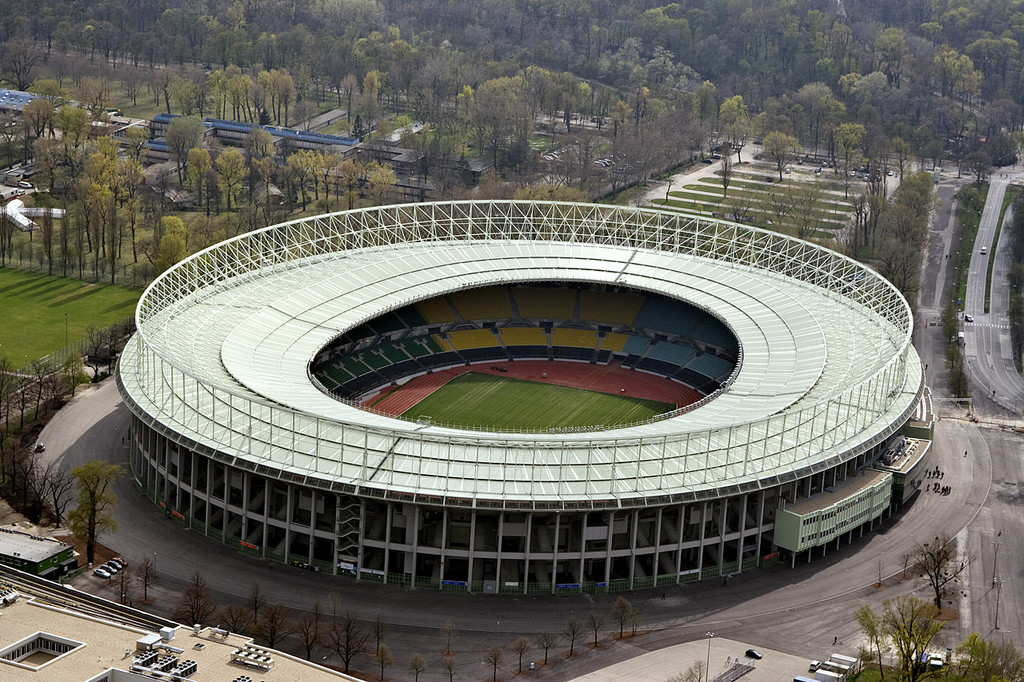
It's Austria's largest stadium with a capacity of 51, 000. Located in Vienna, it is the home of the Austrian National team as well as local side Rapid Vienna, but only for a short period of time.
2. Stade de France
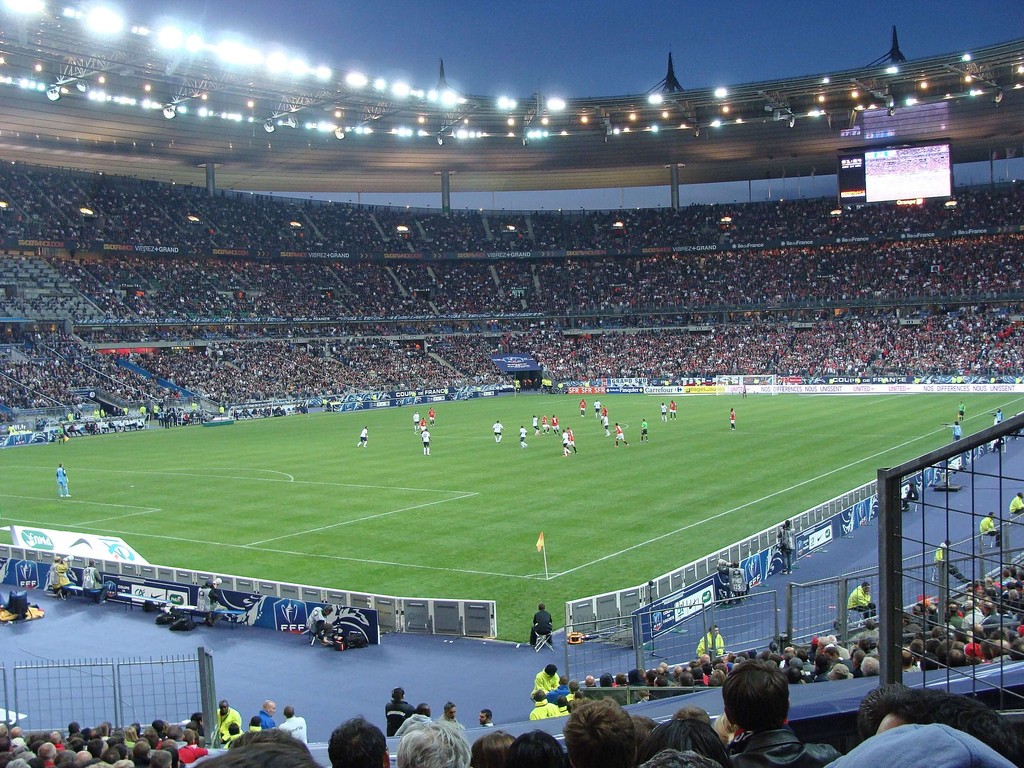
France's home of both rugby and football, the Stade de France is Europe's sixth largest stadium, holding up to 81, 000 people.
3. Stade Vélodrome
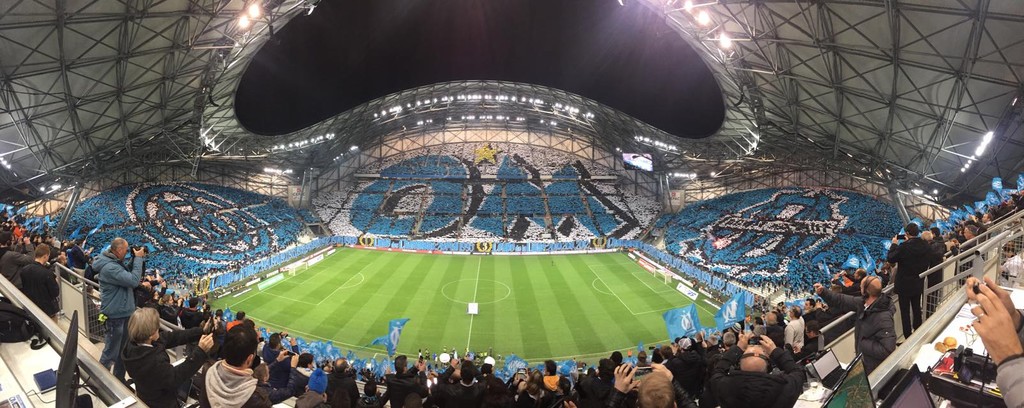
Home to Ligue 1 side Olmpique de Marseille, after the latest of many renovations throughout its history in 2014, the Stade Velodrome now boasts a large maximum capacity of its own, able to hold 67, 000.
4. Olympiastadion
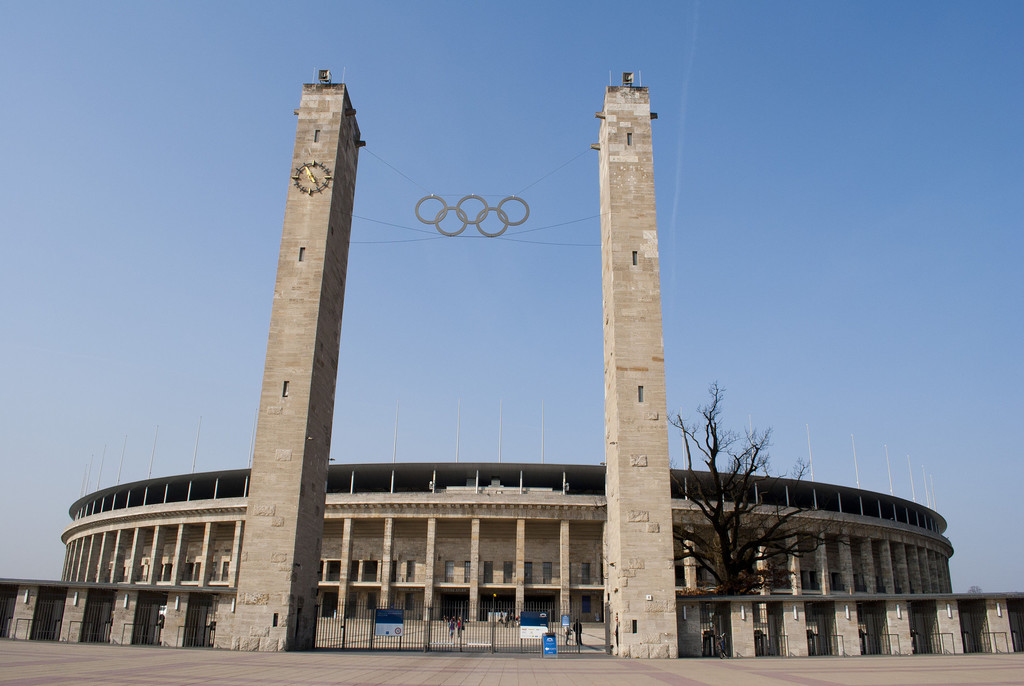
Although the German national team don't have a national stadium to play in, Hertha Berlin's home plays host to the German Cup final each year. This amazing Olympic Stadium can hold up to 75, 000 people.
5. Allianz Arena
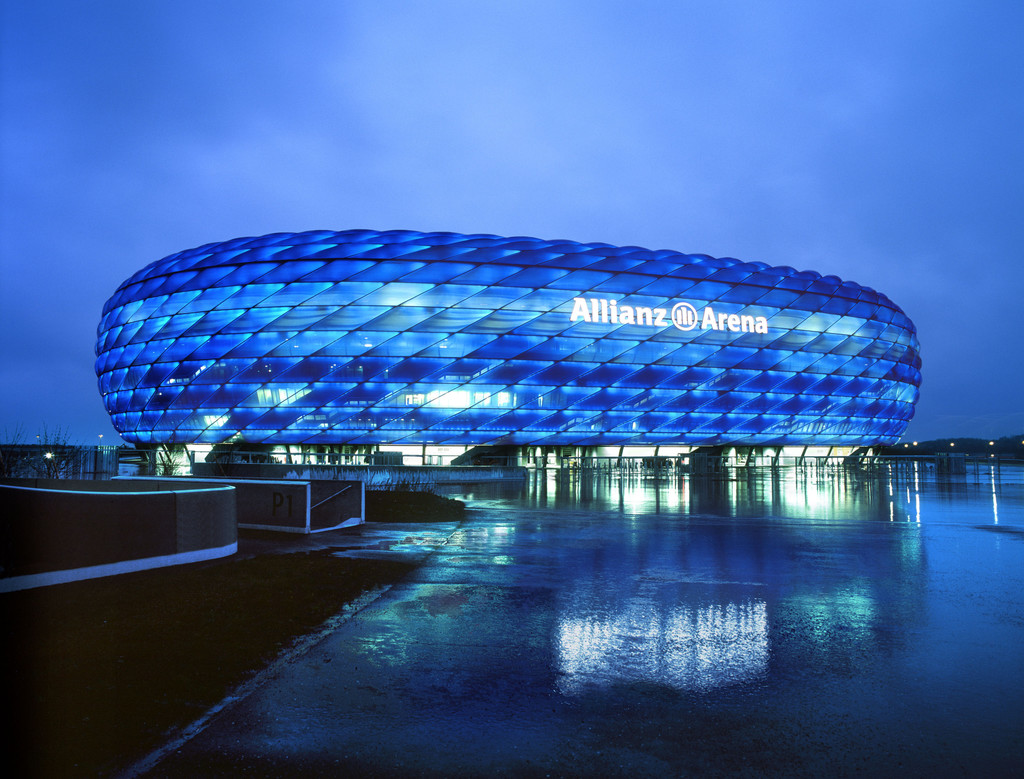
Seems only fair that one of Europe's best clubs has one of its best stadiums as its home too. The Allianz Arena is a marvel in itself, holding up to 75, 000 people, the home of the German champions is just as famous for its ability to light up as it is for the football played inside.
6. Wesfalenstadion / Signal Iduna Park

Famous for the fans within it, Dortmund's home may not be as colourful as rivals Bayern's stadium but the atmospehere the fans create is second to none. Their 'yellow wall' of fans is famous for the array of images they have created and the noise they make. With a max capacity of 80, 000, you can imagine how loud it must be.
7. Olympic Stadium / Spiros Louis
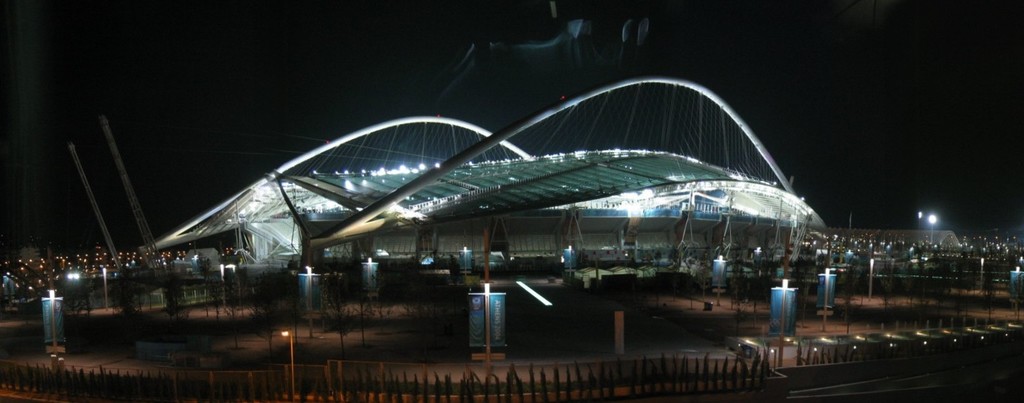
Athens' Olympic Stadium holds 70, 000 and is home to local side AEK Athens.
8. Juventus Stadium

Opened only four years ago, Juventus' new stadium may be small compared to others we have already seen (41, 000) but what it lacks in size it makes up for in appearance. You should hope so too after it cost €120 million to build.
9. Stadio Giuseppe Meazza / San Siro
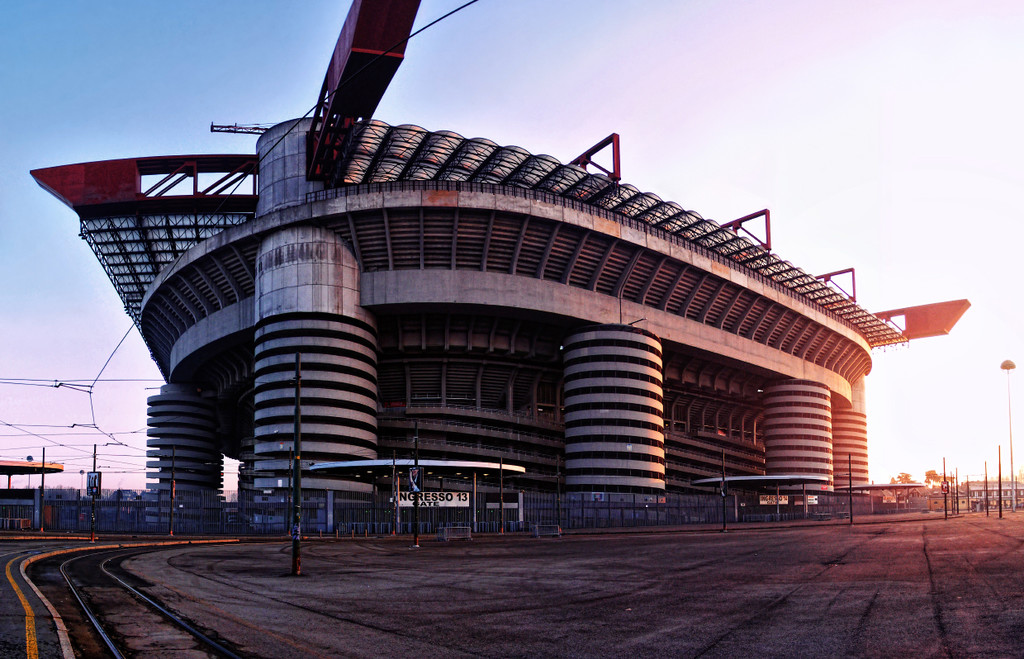
One of the most famous stadiums in all of Europe, and most unique, the San Siro as it is more commonly known is home to both giants of Milan. Both Inter and A. C. are going through a tough time at the moment but there 80, 000 seater stadium will never stop being impressive.
10. Philip II Arena
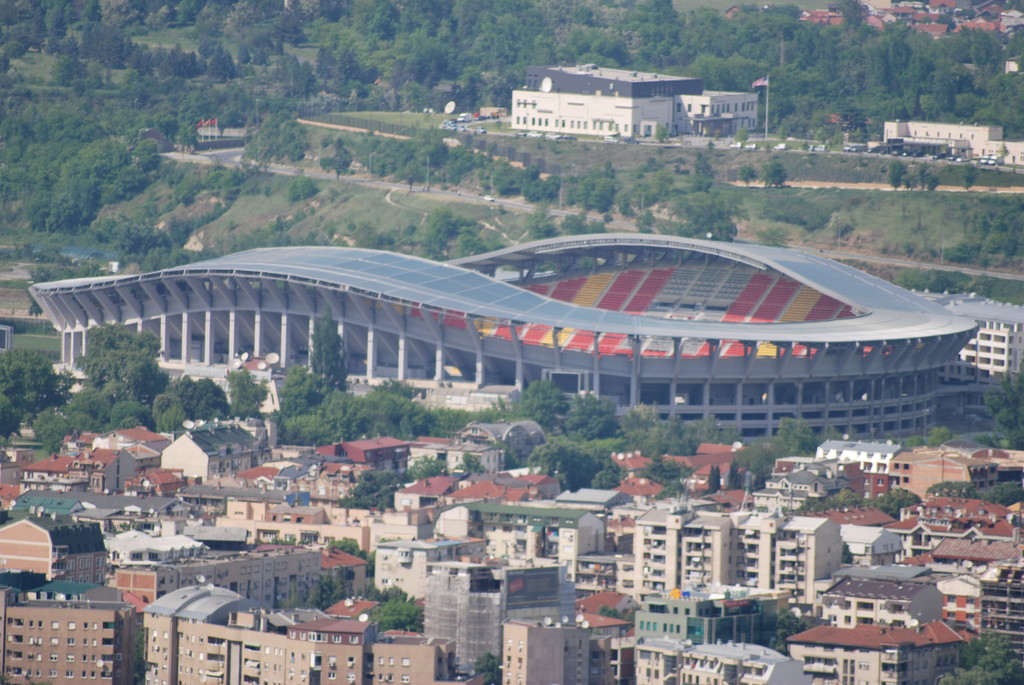
The first of the real minnow countries to feature as of yet. Macedonia's national stadium may only hold 33, 000 but that doesn't make it any less stunning. They might not have the most successful national team, but there is no doubt the Philip II Arena is worthy of its place in this article.
11. Stade Louis II
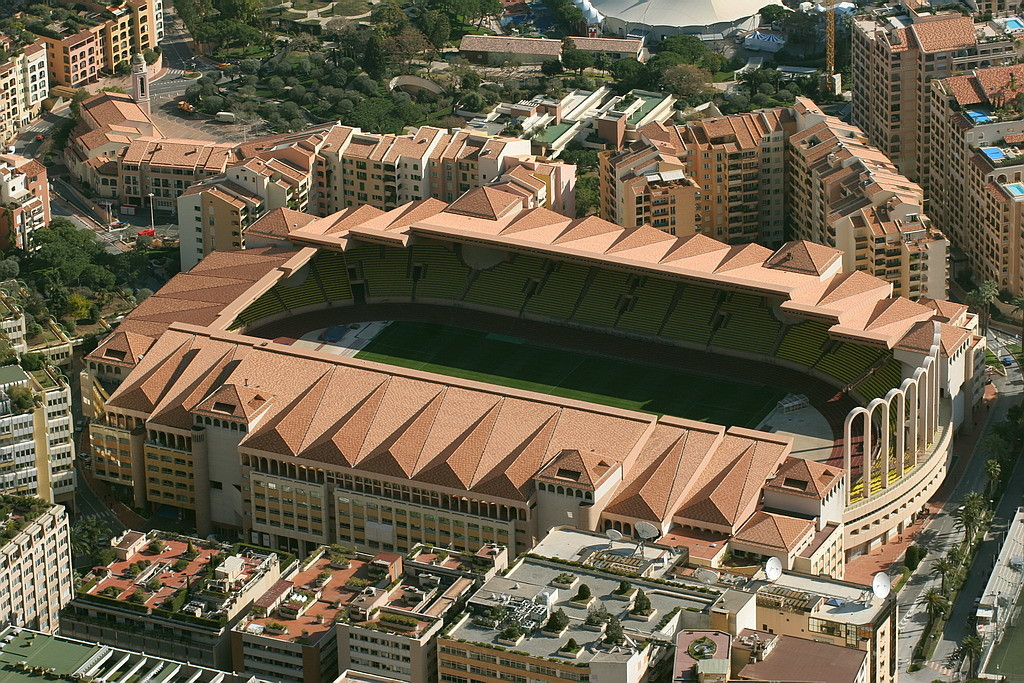
It would be hard not to build a beautiful stadium in this part of the world, but nevertheless, Ligue 1 side Monaco did it. It is the smallest on the list, holding only 18, 500, but just like the stadium above, Stade Louis II certainly shows size doesn't always matter.
Netherlands
12. amsterdam arena.

Home to Dutch side Ajax, the 53, 000 seater Amsterdam ArenA is a beautiful stadium. Not that this comes as any real surprise given that Ajax are known for their eye catching style of play and equally as attractive kit.
13. Estadio da Luz
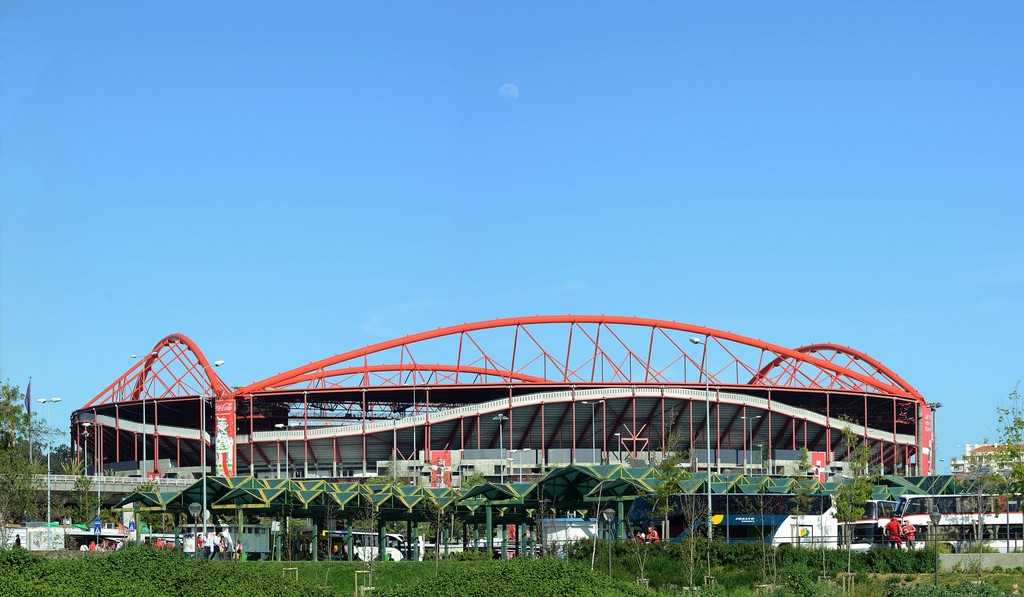
Not that Sunderland's own 'Stadium of Light' is an eye-sore, but when comapred to Benfica's stunning 65, 000 capacity home, it simpley pales in significance.
Republic of Ireland
14. aviva stadium.
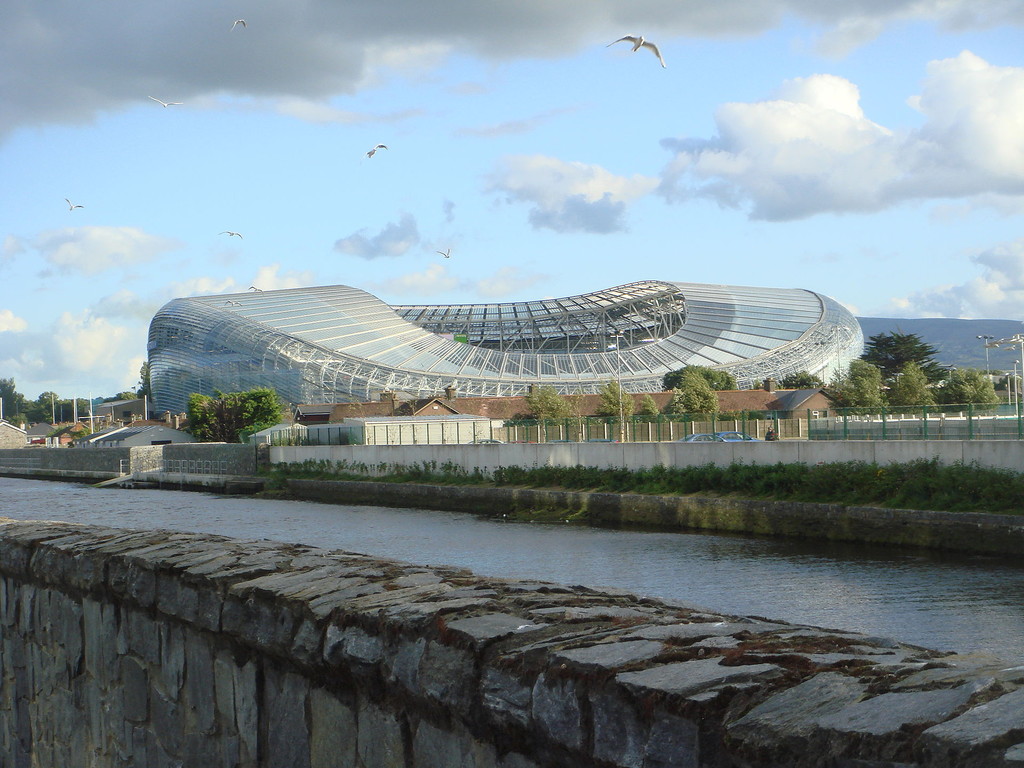
Ireland's preference towards rugby hasn't stopped them building a fantastic looking stadium. Home to the Irish national team, the Aviva stadium holds 51, 000 and is far from out of place on this list.
15. Arena Națională
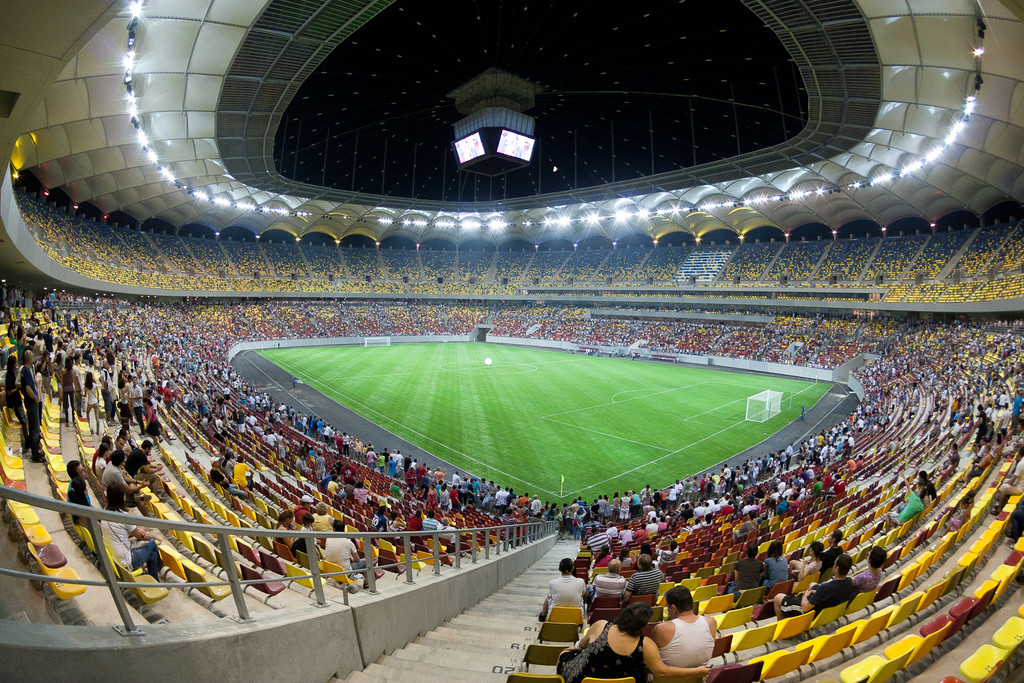
Another surprise inclusion I would imagine. Romania's footballing prowess is far from revered, but regardless of their ability, the national team along, with Bucharest's two local teams (Steaua and Dinamo), have one of the most impressive stadiums in Europe.
Like Juventus' it was opened in 2011, but unlike the Italian side it holds around 15, 000 more (55, 000) and cost double the amount to build, a massive €235. 5 million to be precise.
16. Luzhniki Stadium
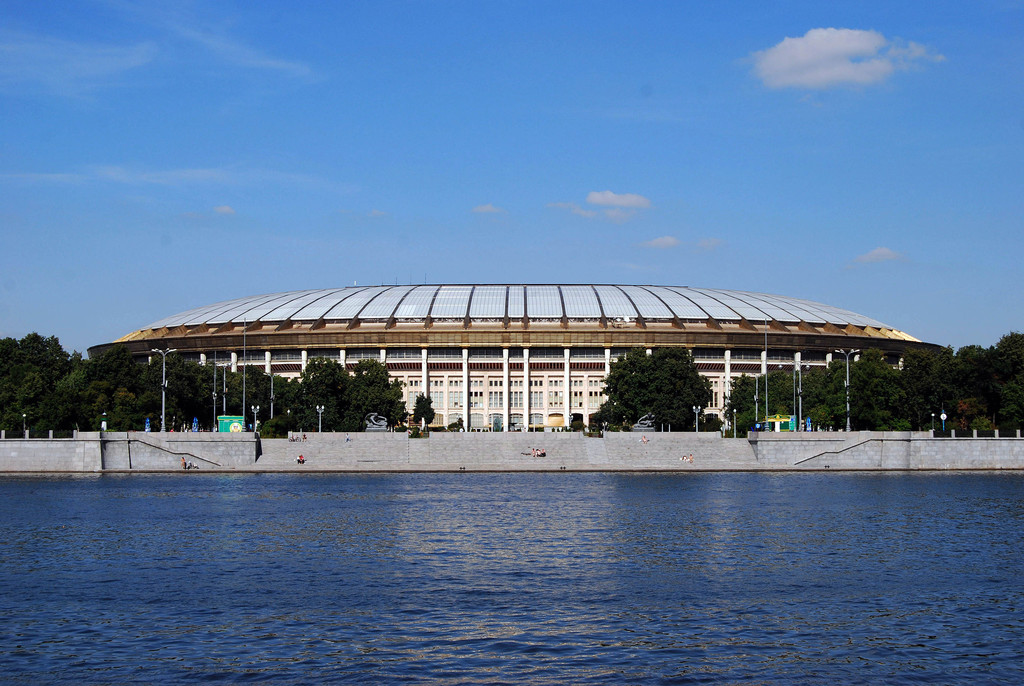
Russia stealing the 2018 World Cup from England was hard to take (especially as given recent developments they most likely bribed their way to getting it) but despite the weather and long distance travel likely to prove problematic, with stadiums like this, at least the venues are impressive.
The Luzhniki stadium holds 78, 000 and should Russia keep the World Cup, it has already been chosen as the venue for the all important final.
17. Camp Nou

Spain don't actually have a national stadium, but with stadiums like this knocking about, why would they need one? With a 99, 000 capacity it's the largest stadium in Europe, let alone Spain.
The stadium tour is amazing but surely no match for actually watching a game. If you get the chance to go, take it. The stadium is a must-see and don't forget they've got some guy called Messi whose supposed to be decent at kicking the ball.
18. Santiago Bernabéu
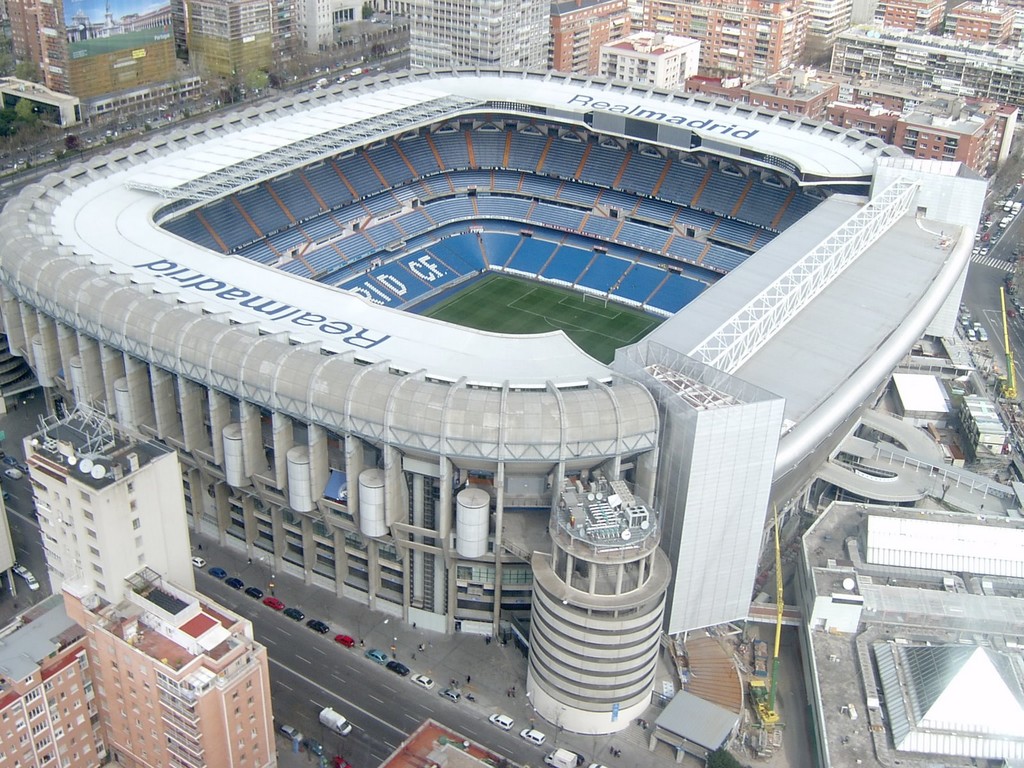
Another amazing Spanish stadium, slap bang in the city centre my old Spanish teacher told me it was like an Alien spaceship had landed in Madrid.
Despite being smaller than the Camp Nou, it's 85, 000 capacity is larger than most other stadiums. Goals are guaranteed when you go to the Bernabéu and just as Barcelona have Messi as their star attraction, the opportunity to see CR7 in the flesh is reason enough to give it a visit.
19. Friends Arena
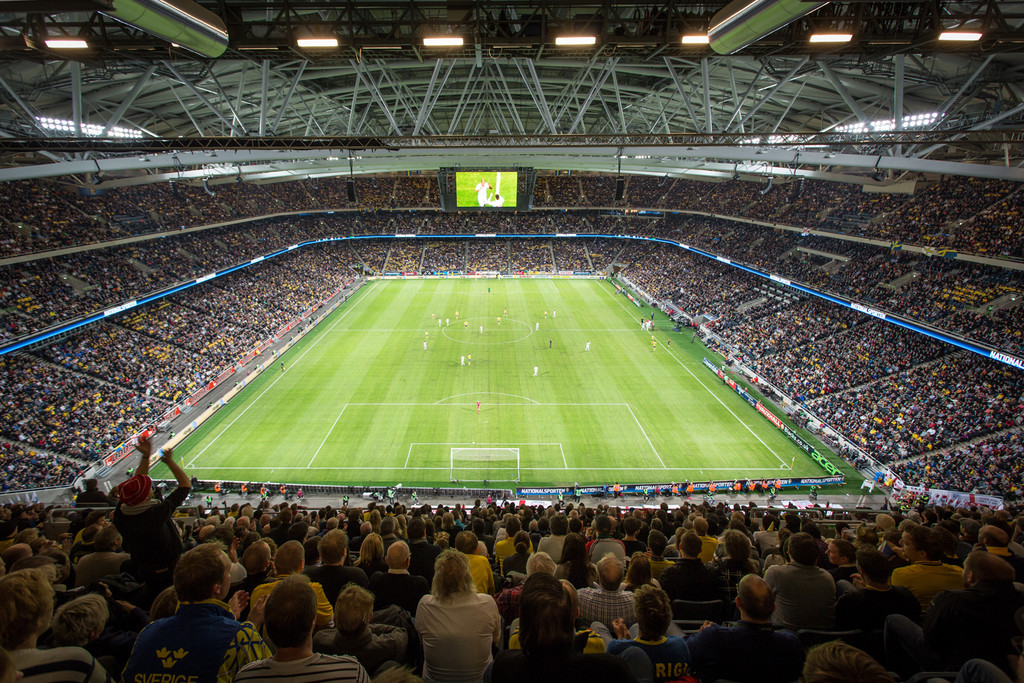
Home to the Swedish national team and league side AIK, the cheerfully named Friends Arena holds 50, 000 people inside. It has a retactable roof and even though it can hold 65, 000 for concerts, the 50, 000 football capacity is enough for it to be crowned the biggest stadium in the Nordic region.
Switzerland
20. stade de suisse / wankdorf bern.
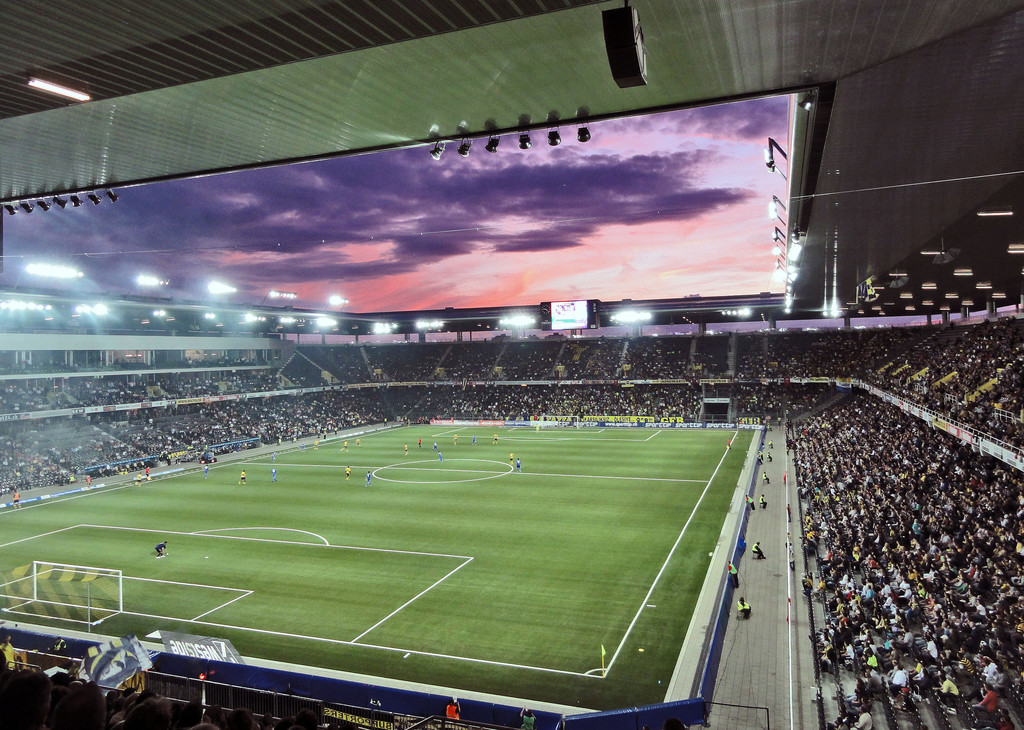
Despite the hilarious name (maybe it's just me) Wankdorf Bern may only hold 32, 000 but with the potential of night skies the same as this as well as an equally as attractive stadium to behold it from, it's well worth a visit should you find yourself in the country.
21. Olimpiyski National Sports Complex

Renovated and reopend in 2011, Ukraine's Olympic Stadium in Kiev holds up to 70, 000 and as you can see from the image above, it's huge capacity isn't the only reason for including it in this article.
United Kingdom
22. wembley.

Doesn't really need an introduction, does it? New Wembley and it's famous arch was opened in 2007 and is the 90, 000 seater home for the England national team. It also hosts the FA Cup semi-finals and finals, as well as all Football league play off finals too. The stadium of choice for all big ocassions.
23. Emirates Stadium

As an Arsenal fan myself I couldn't leave it out. But bias aside, there is no doubt the Emirates is one of, if not the most stunning stadium in England. It's 60, 000 capacity isn't the largest but with padded seats, a pristine pitch and mesmerising football played on top of it, the North London side's stadium is one of the best around.
24. Old Trafford

Impressive in terms of size, Old Trafford might not be the most modern stadium on the list but the history behind it on top of its 75, 000 capacity makes the Theatre of Dreams one of the best places to watch football.
25. Celtic Park
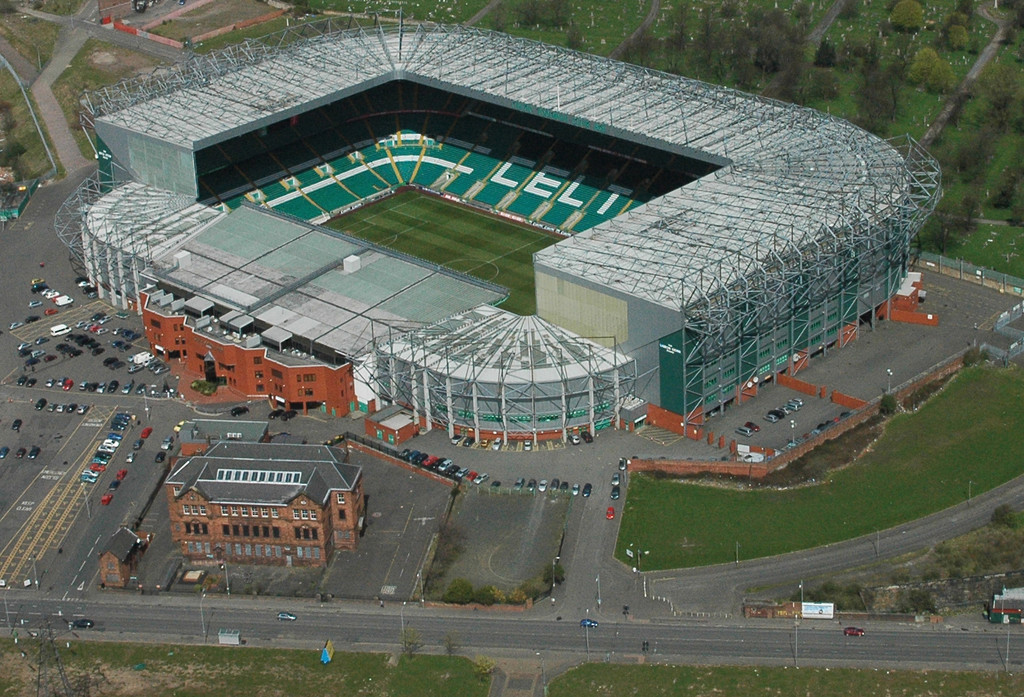
Whils Hampden Park plays host to the national team, Celtic park is home to one of the most famous teams around. Scottish football isn't the best by any means but on a Champions League night, or an Old Firm Derby for that matter, you'll be pressed to find a better atmosphere than the one this 60, 000 seater has to offer.
26. Millennium Stadium
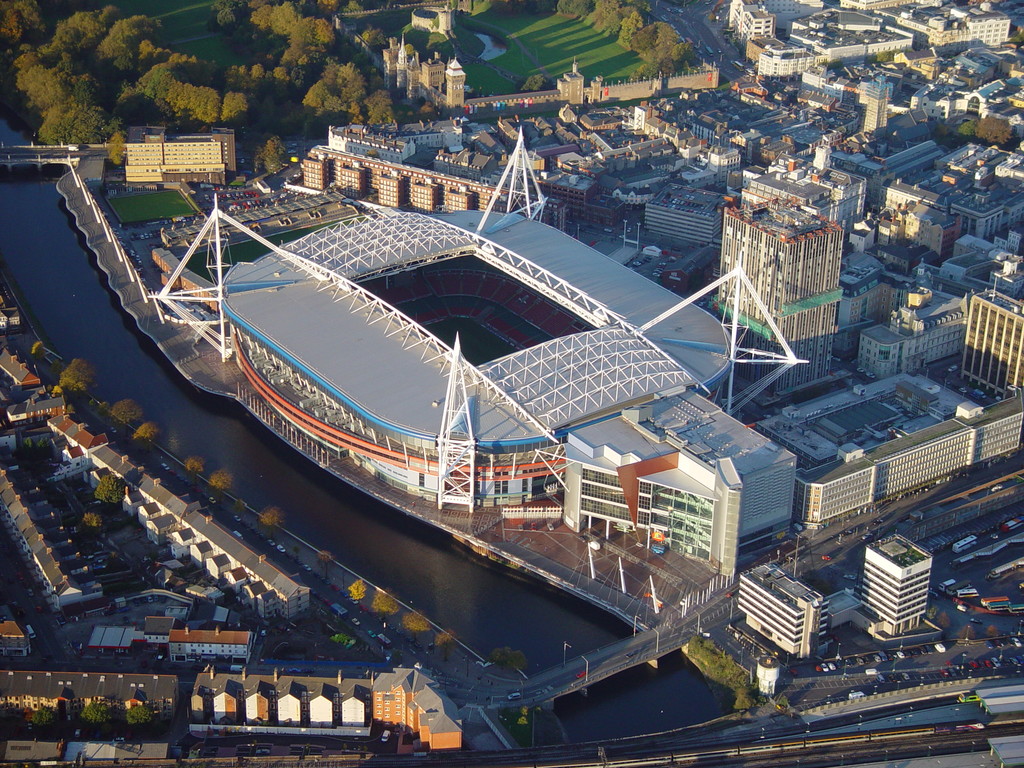
In the absence of Wembley during its renovation, the Millennium stadium provided a more than adequate replacement for England's biggest matches. The 75, 000 seater stadium is more commonly used for Rugby games, but the Welsh football team also call it there home.
Your year abroad means you could end up in any of these places!
Even if you don’t it’s so easy to travel around Europe that should you get the chance to visit somewhere else, football fan or not, these incredible stadiums are a must see.
I hope you enjoyed the article and once again I apologise for having to leave some off. If you want, add your favourites in the comments below.
Photo gallery

Content available in other languages
- Polski: 26 najlepszych stadionów piłkarskich w Europie
- Français: Les 26 meilleurs stades de football d'Europe
- Türkçe: Avrupa'daki en iyi 26 futbol stadyumu
- Português: 26 dos melhores estádios de futebol da Europa
Comments (1 comments)

Brain Phillip 7 years ago
Nicely described all info at one place, but some other gigantic football stadiums are also need to add. Like I also found a great list of largest stadiums at https://www.footballpulp.com/champions-league/largest-football-stadiums-in-europe/
Want to have your own Erasmus blog?
If you are experiencing living abroad, you're an avid traveller or want to promote the city where you live... create your own blog and share your adventures!
More publications in this category
- Motion Hospitality: Your Premier Event Management Partner in Dubai and KSA
- Golden sands
- obox Nocode Metaverse Studio Unveils Pioneering Enhancements, Commemorates Over 12,000 Visionaries
- Discover the Top 10 Camping Chairs of 2024: Comfort and Convenience for Outdoor Enthusiasts
- Mountain Tatry
Don’t have an account? Sign up .
- Erasmus destinations
- Erasmus universities
- Erasmus cities Ranking
- Erasmus universities Ranking
- Erasmus students
Erasmus content
- Erasmus forum
- Erasmus blog
- Erasmus experiences
- Erasmus places
- Erasmus student housing
- Student jobs
- Erasmus photos
About Erasmusu
- Erasmusu Help Center
- Join us! Job offers and internships
- Instagram New!
- Erasmusu blog
- Terms of use
- Privacy and Cookie Policy
Languages available

ERASMUS® is a registered trademark owned by the European Union and represented by the European Commission. This website is just a Social Network or Online Community for international students and is not related in any way to the ERASMUS® trademark. This website is not related to the European Union and the European Commission either.
Wait a moment, please

10 Most Popular Football Stadiums In Europe
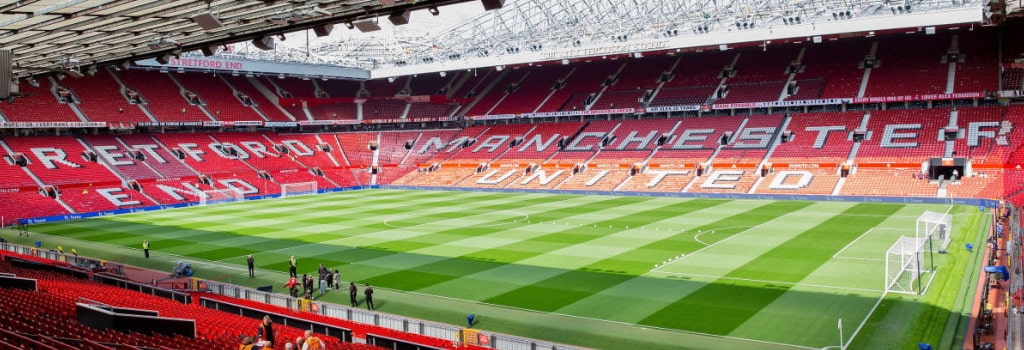
Football holds a unique place in the heart of Europe. With its rich history and die-hard fan base, the game is woven into the fabric of European society. Stadiums, seen as sacred grounds by football enthusiasts, encapsulate the electric atmosphere, the heart-throbbing action, and the unparalleled passion of the fans. Here, we will journey through the 10 most popular football stadiums in Europe, exploring their unique charms, history, and the unforgettable moments they have witnessed.
1. Camp Nou, Barcelona
Camp Nou, the fortress of FC Barcelona, is the largest football stadium in Europe. With a staggering capacity of almost 99,354 spectators, it is a place where magic comes alive. Legends like Messi, Xavi, and Iniesta have graced its stands. In addition, the stadium resonates with "Més que un club" (More than a club), embodying a sense of unity and belongingness that makes every visit unforgettable.
2. Old Trafford, Manchester
Known as the 'Theatre of Dreams', Old Trafford is the emblem of Manchester United. This stadium, a favorite among fans who bet on soccer , has been home to the Red Devils since 1910 and has staged many iconic football moments. Its aura, coupled with a capacity of over 74,000, makes it a bucket-list destination for football lovers worldwide. The blend of history and modernity encapsulated within its stands breathes life into every match.
3. Allianz Arena, Munich
With its futuristic architecture and radiant exterior, the Allianz Arena is a gem of Munich. Home to Bayern Munich, it can accommodate 75,000 spectators. Known for its unique diamond exterior that can change color, the stadium embodies the dynamism of modern football while offering an enchanting football experience.
4. Santiago Bernabeu, Madrid
A timeless classic, the Santiago Bernabeu is the heart of Real Madrid. With a capacity of 81,000, the stadium has been witness to some of the greatest chapters in football history. From thrilling El Clasicos to Champions League nights, its aura is simply captivating, making it one of Europe's most cherished football destinations.
5. Wembley Stadium, London
With a capacity of 90,000, Wembley Stadium is synonymous with England's football legacy. Its iconic arch is recognizable worldwide and has hosted countless memorable events, from FA Cup finals to Olympic football matches and other sports matches . In addition, the colossal stadium stands as a symbol of unity and sporting spirit.
6. Anfield, Liverpool
Anfield, the home of Liverpool FC, is renowned for its electrifying atmosphere. The famous "This is Anfield" sign, and the unique singing of "You'll Never Walk Alone" create an unmatched ambience. With a capacity of over 53,000, Anfield captures the pure essence of football, creating an indelible experience for its visitors.
7. Signal Iduna Park, Dortmund
Best known for the Yellow Wall, Signal Iduna Park is home to Borussia Dortmund. With a capacity of over 81,000, it holds the record for the highest average attendance in Europe. In addition, the stadium is known for its passionate supporters, who create a wall of sound and color that is awe-inspiring.
8. Stadio Giuseppe Meazza, Milan
Also known as San Siro, this iconic stadium in Milan is shared by AC Milan and Inter Milan. The Stadio Giuseppe Meazza, with its distinctive spiral walkways, can accommodate over 80,000 spectators. A testament to Italian football's heritage, it delivers an authentic, passionate match-day experience.
9. Parc des Princes, Paris
The Parc des Princes is more than just a stadium for Paris Saint-Germain (PSG). It's a symbol of the club's ambition and style. With a capacity of 47,929, this stadium's design is focused on keeping spectators close to the action. It's famous for its electric atmosphere, especially on European nights when the air is thick with anticipation and excitement.
10. Estadio da Luz, Lisbon
Estadio da Luz, translated as the Stadium of Light, is the home ground of SL Benfica. With a seating capacity of 65,000, it's the largest stadium in Portugal. The stadium is renowned for its stunning architecture and the remarkable ambience created by passionate Benfica fans. It's a vivid symbol of Portugal's love for football and embodies their national spirit in the sport.
Each football stadium in Europe has its unique character, story, and significance that reflect the game's culture, passion, and history. From Anfield's electrifying atmosphere to the Allianz Arena's architectural beauty, these are more than just structures of steel and concrete. They are the heart and soul of the beautiful game in Europe, hosting unforgettable moments and creating lifelong memories for football enthusiasts around the globe. Exploring these iconic stadiums brings us closer to understanding why football is so deeply loved and profoundly influential in this part of the world.
More articles from Football Ground Map...

My Son's First Football Match
Taking my son to his first football match was one of the best experiences I've had as a father so far. I've written this article for Alex to read when he gets older.
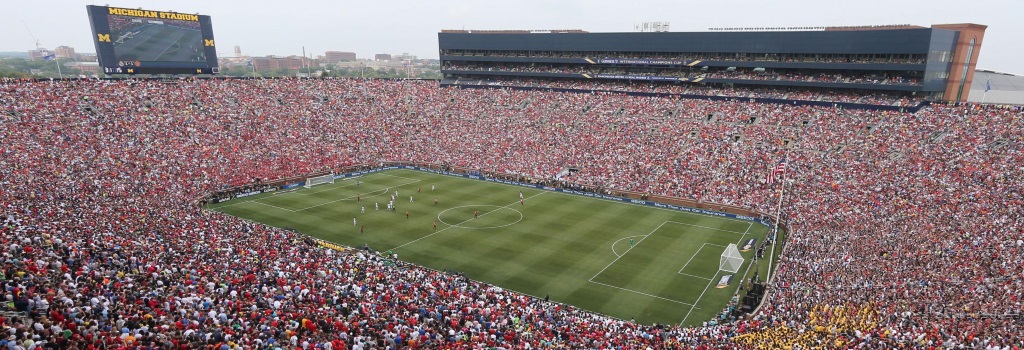
The biggest football attendances ever recorded
An in-depth look at the biggest football attendances ever recorded, from the 1950 World Cup to pre-season friendlies in the States and the Scottish ground with dozens of 100,000+ attendances

The World's Barmiest Football Fan?
Tony Incenzo has been to over 2,000 football grounds - is he the world's barmiest football fan? Read about his love for Non-League football and groundhopping obsession, including watching a match in prison!

Surviving football boredom - a football fans' guide
23 interesting things to do to pass the time until the football season restarts

COMMENTS
Let us dive into some of the most famous, heart touching, beautiful structures we call football stadiums in the land of palaces and castles – Europe. Table of Contents. 1. Camp Nou, Spain. 2. Wembley Stadium, London. 3. Croke Park, Dublin. 4. Signal Iduna Park, Dortmund. 5. Santiago Bernabéu Stadium. 6. Stade de France, Paris. 7.
Ranking the 16 Best Stadiums in Europe for Fans to Visit | News, Scores, Highlights, Stats, and Rumors | Bleacher Report. What’s your favourite football stadium? Is it the one where...
The 13 grounds you must visit on a European football road trip. Being in Europe means being on the doorstep of a bottomless pit of opportunity to catch some truly brilliant football matches, across cities packed with culture. While there are some truly mesmerising football stadiums and genuine bucket list pipedreams of stadiums we’d love to ...
Here is a list of some most insane, famous and beautiful football stadiums located in the land of palaces and castles, Europe for 2022.
talkSPORT.com has rated the 30 best stadiums on the continent, and you can see the full ranking, from 30th to first, below... 30. Stamford Bridge, London. Built in 1876 as an athletics stadium ...
Of the 50 stadiums analysed, Signal Iduna Park (5.94) – home of Borussia Dortmund and site of the Euro 2024 semi-final – ranks in first position as the best stadium in Europe.
Europe's top football stadiums have been ranked by factors like capacity, ticket prices, and disabled access.
Get ready to immerse yourself in the heart-pounding world of European football as we take you on a virtual journey through the continent's most iconic stadiu...
Russia stealing the 2018 World Cup from England was hard to take (especially as given recent developments they most likely bribed their way to getting it) but despite the weather and long distance travel likely to prove problematic, with stadiums like this, at least the venues are impressive.
Here, we will journey through the 10 most popular football stadiums in Europe, exploring their unique charms, history, and the unforgettable moments they have witnessed. 1. Camp Nou, Barcelona. Camp Nou, the fortress of FC Barcelona, is the largest football stadium in Europe.